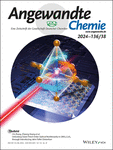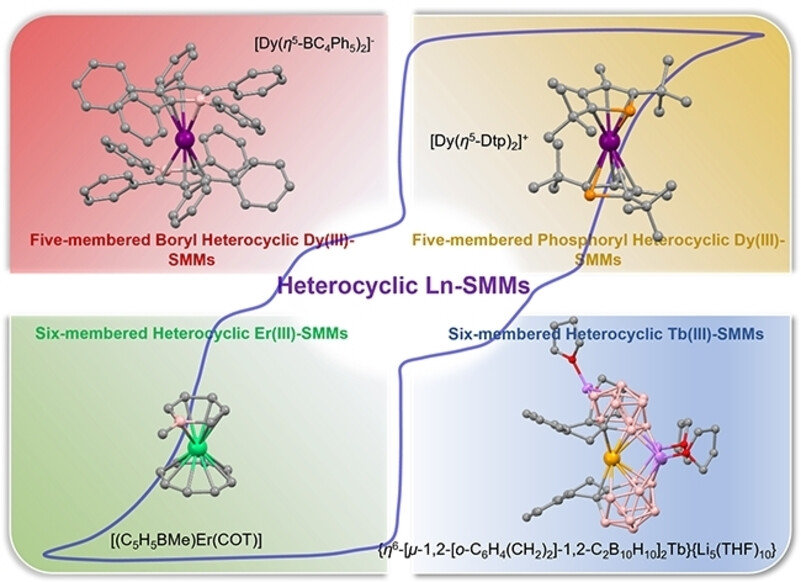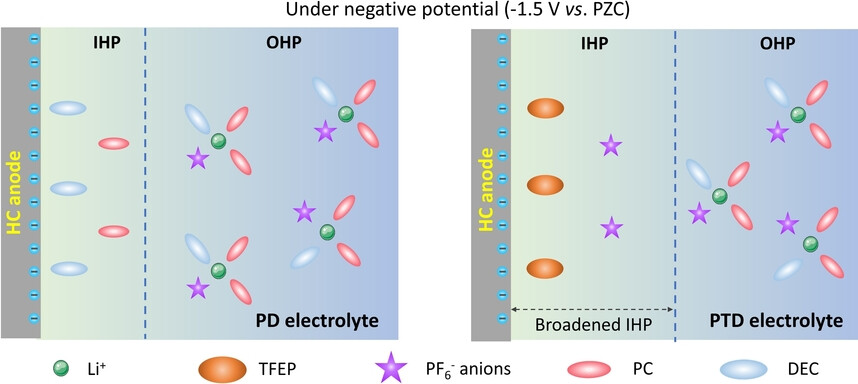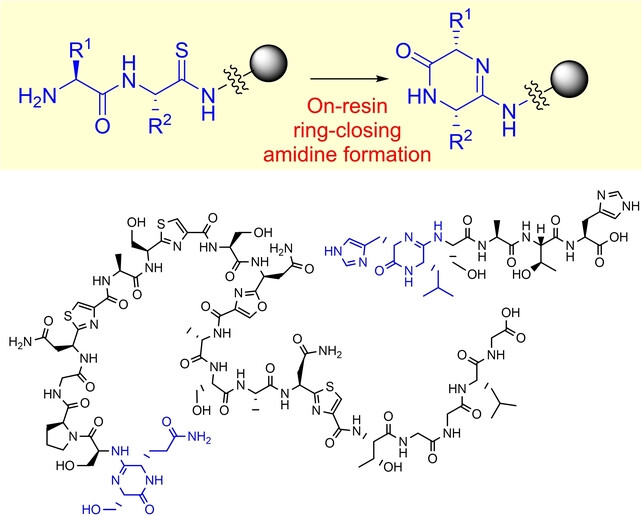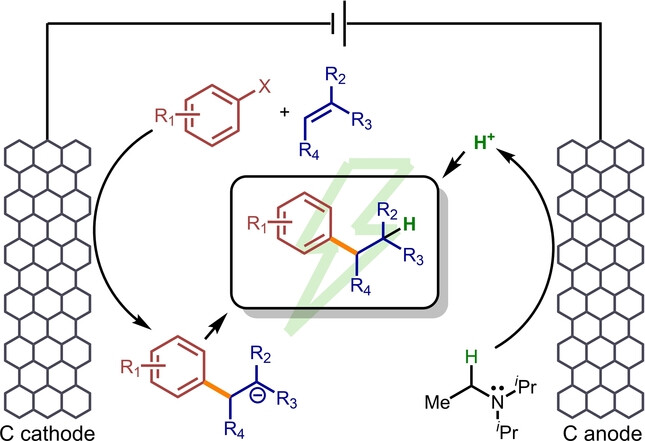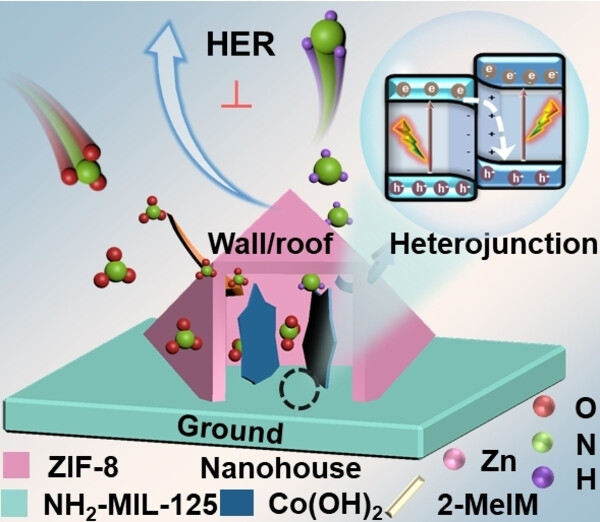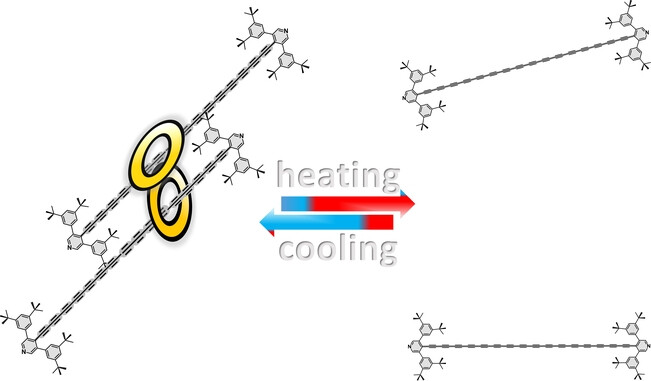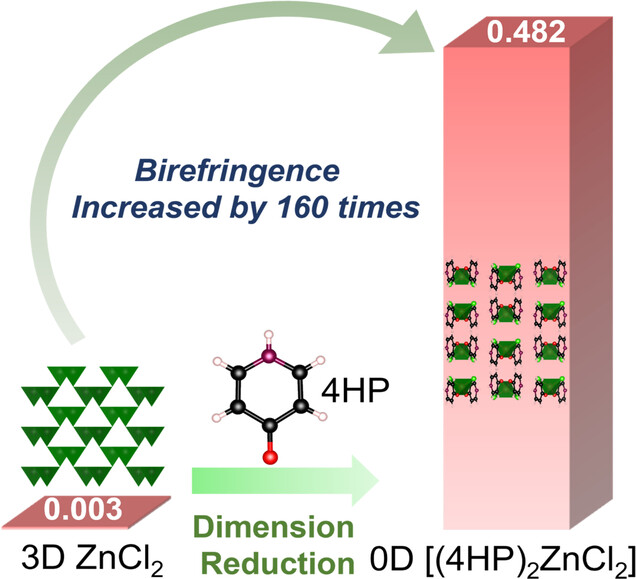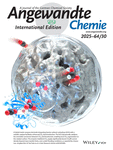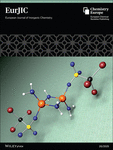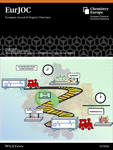Journal list menu
Export Citations
Download PDFs
Cover
Titelbild: Unlocking Giant Third-Order Optical Nonlinearity in (MA)2CuX4 through Introducing Jahn-Teller Distortion (Angew. Chem. 38/2024)
- First Published: 06 August 2024
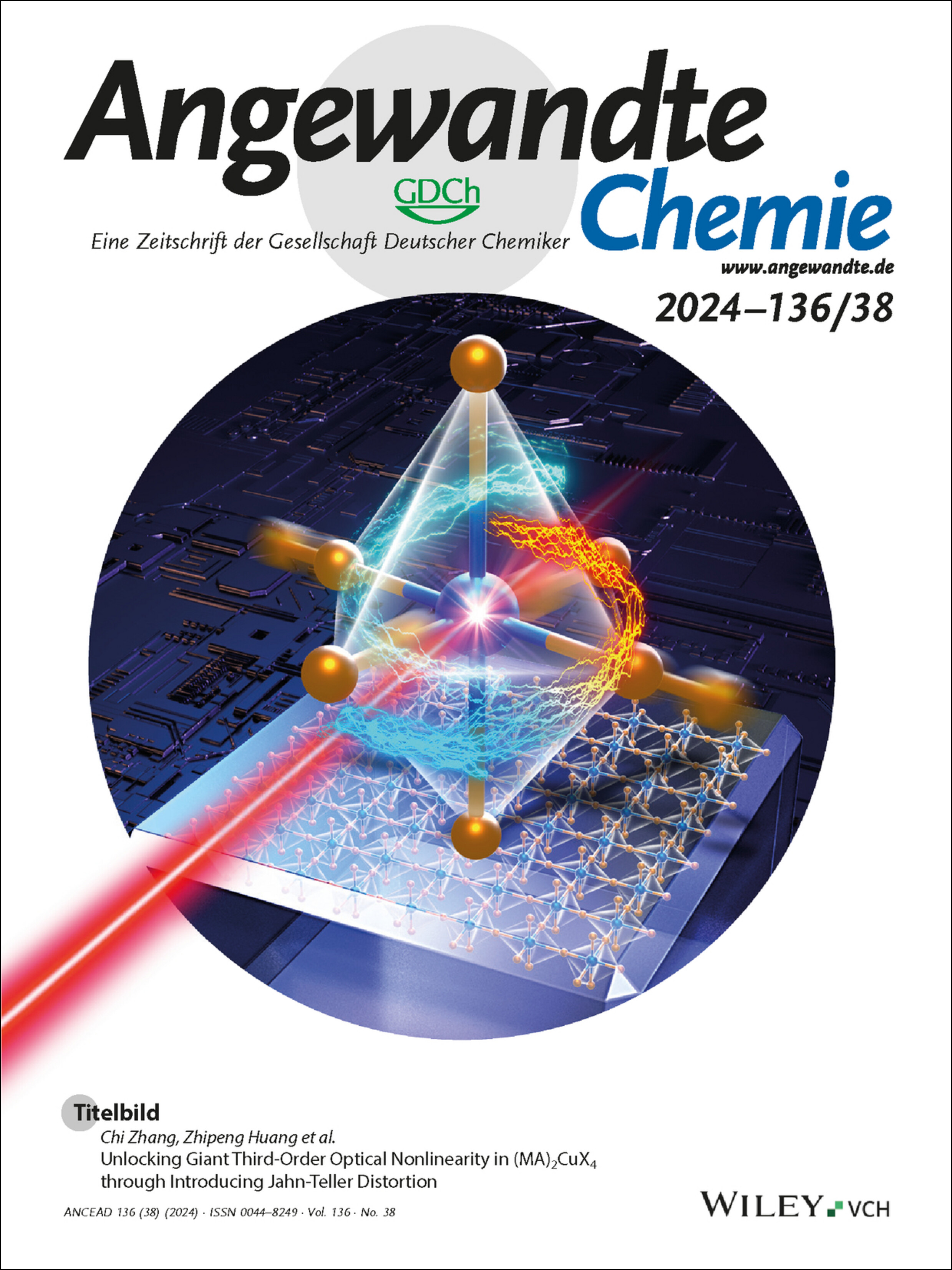
Incorporating Jahn–Teller distortion into a Mott–Hubbard system emerges as an effective strategy for developing high-performance nonlinear optical materials. In their Research Article (e202406941), Chi Zhang, Zhipeng Huang employ lattice distortion to provide two distinct transition pathways with varying probabilities, while the Mott–Hubbard configuration ensures the transition sequence. This synergistic design unveils the excited-state absorption in (MA)2CuX4, enabling these materials to simultaneously exhibit a large nonlinear absorption coefficient and substantial modulation depth.
Innentitelbild: Amorphous FeSnOx Nanosheets with Hierarchical Vacancies for Room-Temperature Sodium-Sulfur Batteries (Angew. Chem. 38/2024)
- First Published: 01 August 2024
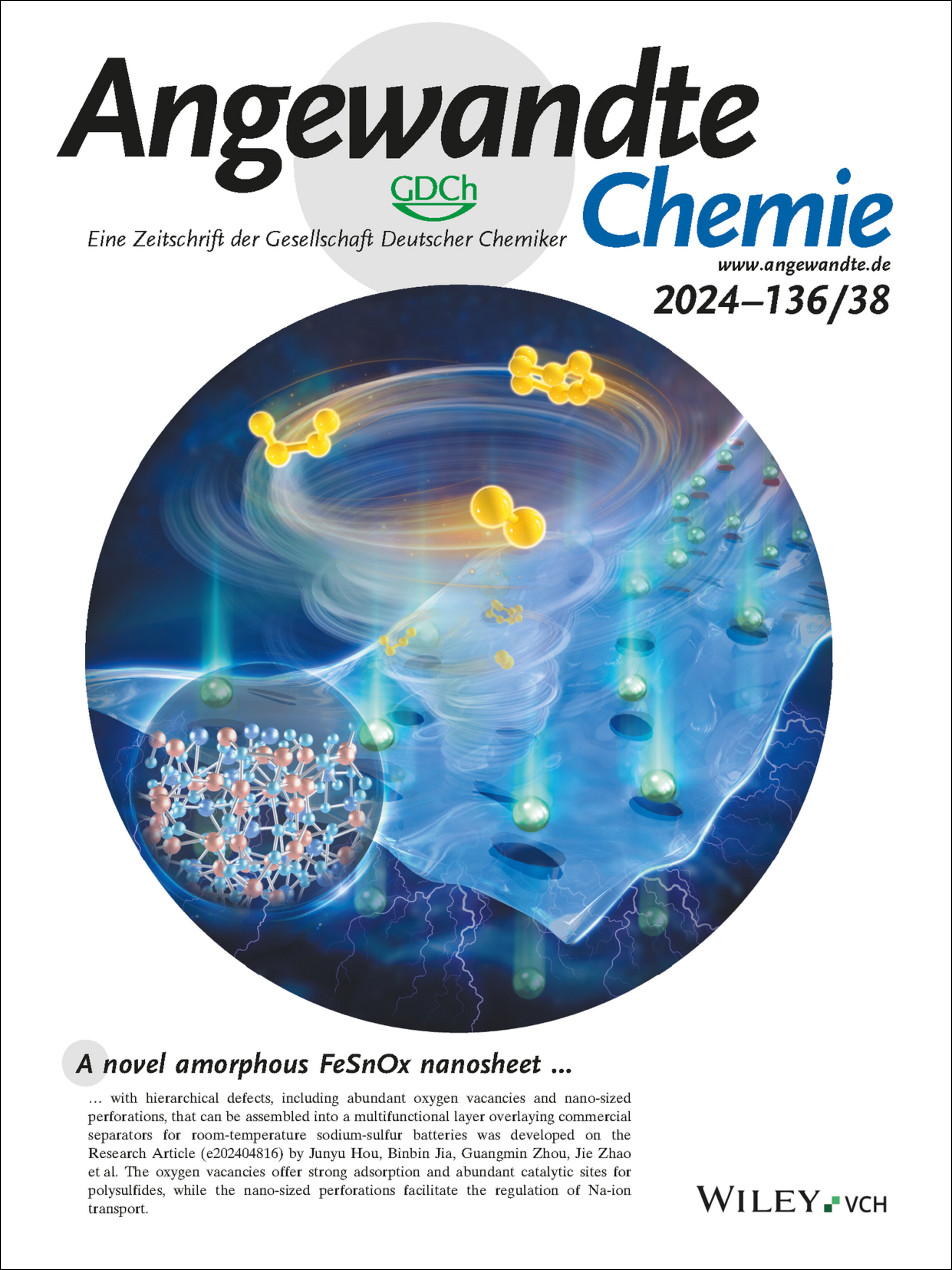
A novel amorphous FeSnOx nanosheet with hierarchical defects, including abundant oxygen vacancies and nano-sized perforations, that can be assembled into a multifunctional layer overlaying commercial separators for room-temperature sodium-sulfur batteries was developed on the Research Article (e202404816) by Junyu Hou, Binbin Jia, Guangmin Zhou, Jie Zhao et al. The oxygen vacancies offer strong adsorption and abundant catalytic sites for polysulfides, while the nano-sized perforations facilitate the regulation of Na-ion transport.
Innenrücktitelbild: From Coordination to π-Hole Chemistry of Transition Metals: Metalloporphyrins as a Case of Study (Angew. Chem. 38/2024)
- First Published: 01 August 2024
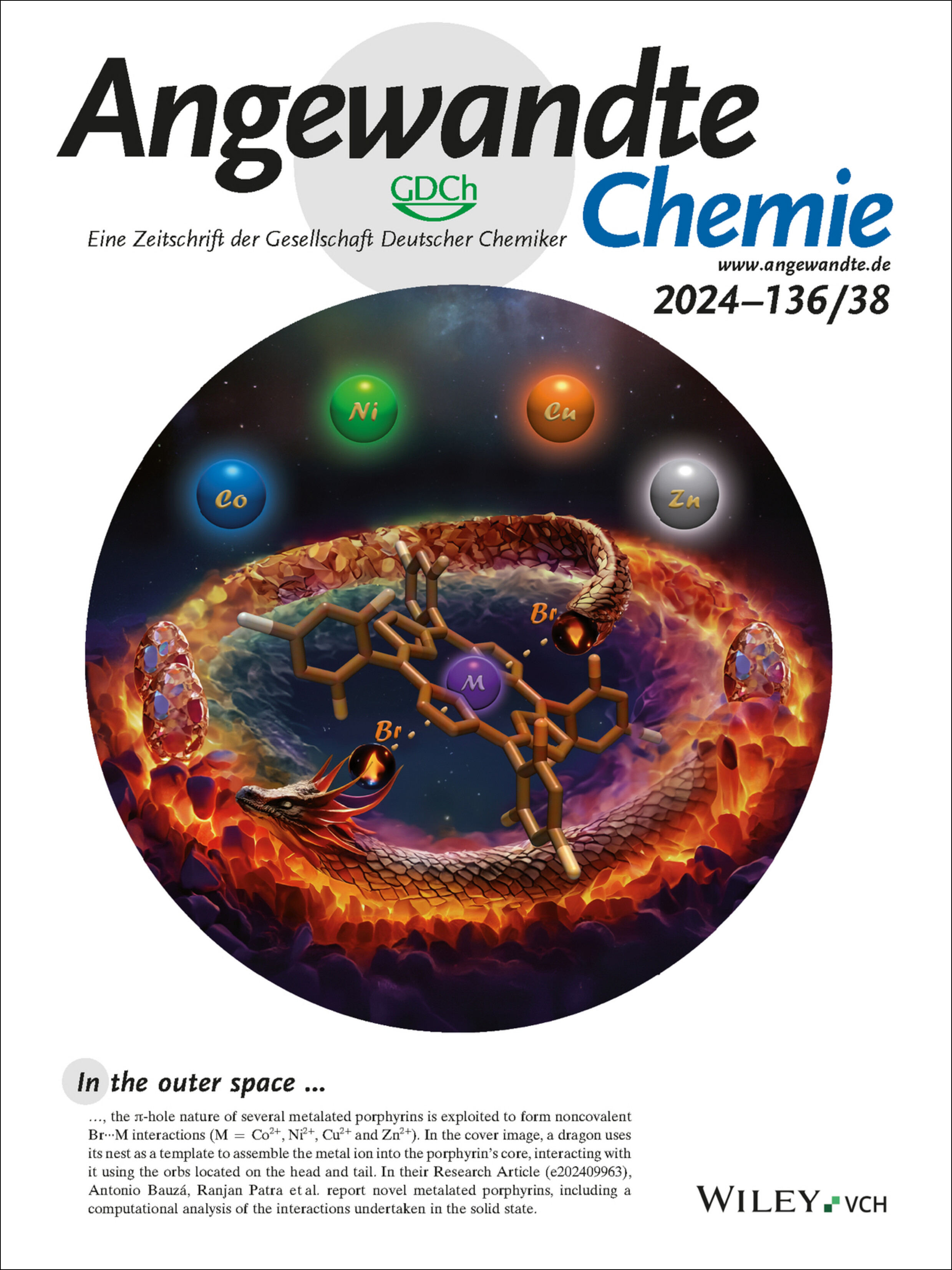
In the outer space , the π-hole nature of several metalated porphyrins is exploited to form noncovalent Br⋅⋅⋅M interactions (M = Co2+, Ni2+, Cu2+ and Zn2+). In the cover image, a dragon uses its nest as a template to assemble the metal ion into the porphyrin's core, interacting with it using the orbs located on the head and tail. In their Research Article (e202409963), Antonio Bauzá, Ranjan Patra et al. report novel metalated porphyrins, including a computational analysis of the interactions undertaken in the solid state.
Rücktitelbild: piSTING: A Pocket-Independent Agonist Based on Multivalency-Driven STING Oligomerization (Angew. Chem. 38/2024)
- First Published: 01 August 2024
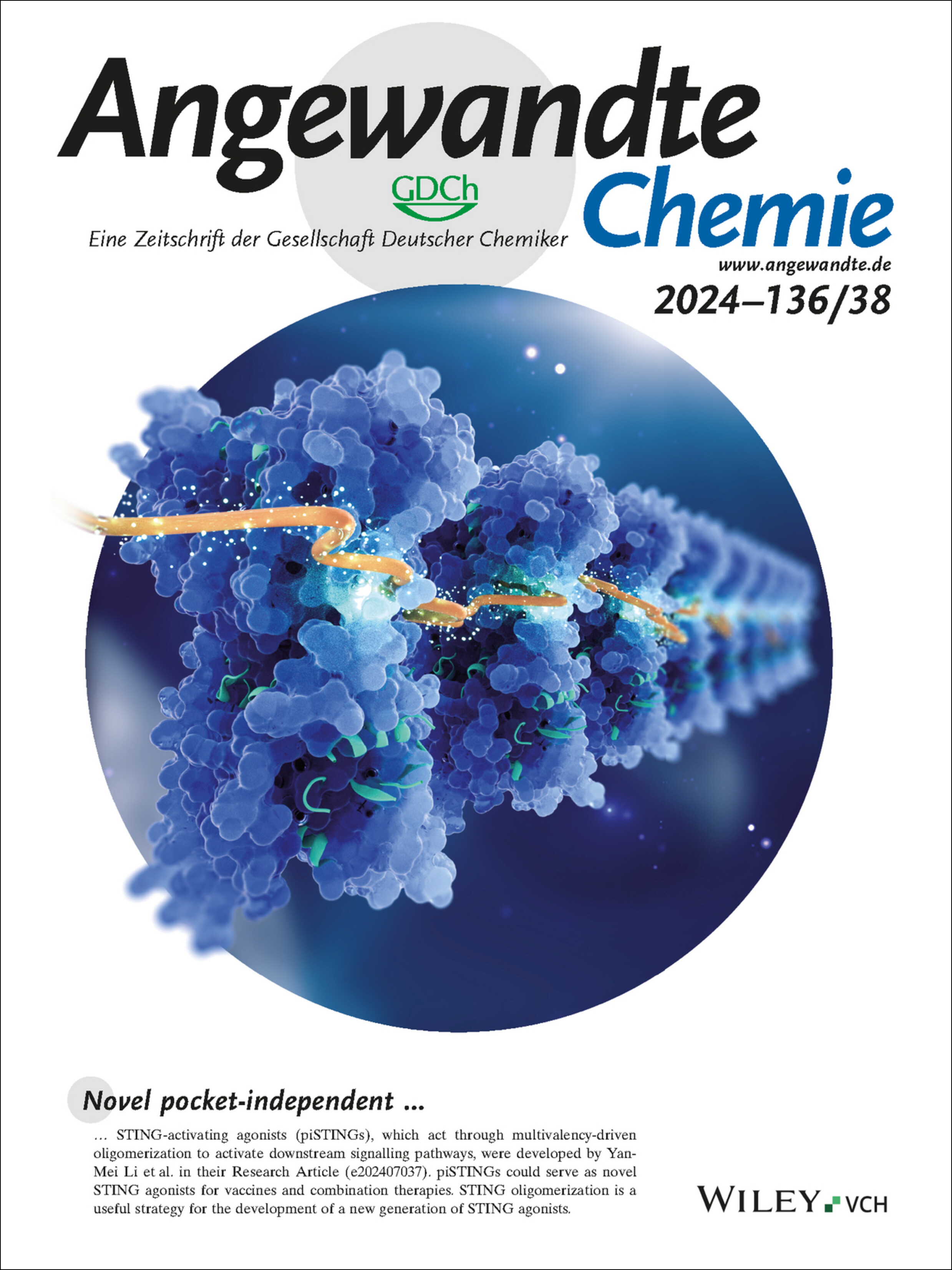
Novel pocket-independent STING-activating agonists (piSTINGs), which act through multivalency-driven oligomerization to activate downstream signalling pathways, were developed by Yan-Mei Li et al. in their Research Article (e202407037). piSTINGs could serve as novel STING agonists for vaccines and combination therapies. STING oligomerization is a useful strategy for the development of a new generation of STING agonists.
Frontispiz
Frontispiz: Ribosome-Free Translation up to Pentapeptides via Template Walk on RNA Sequences
- First Published: 12 September 2024
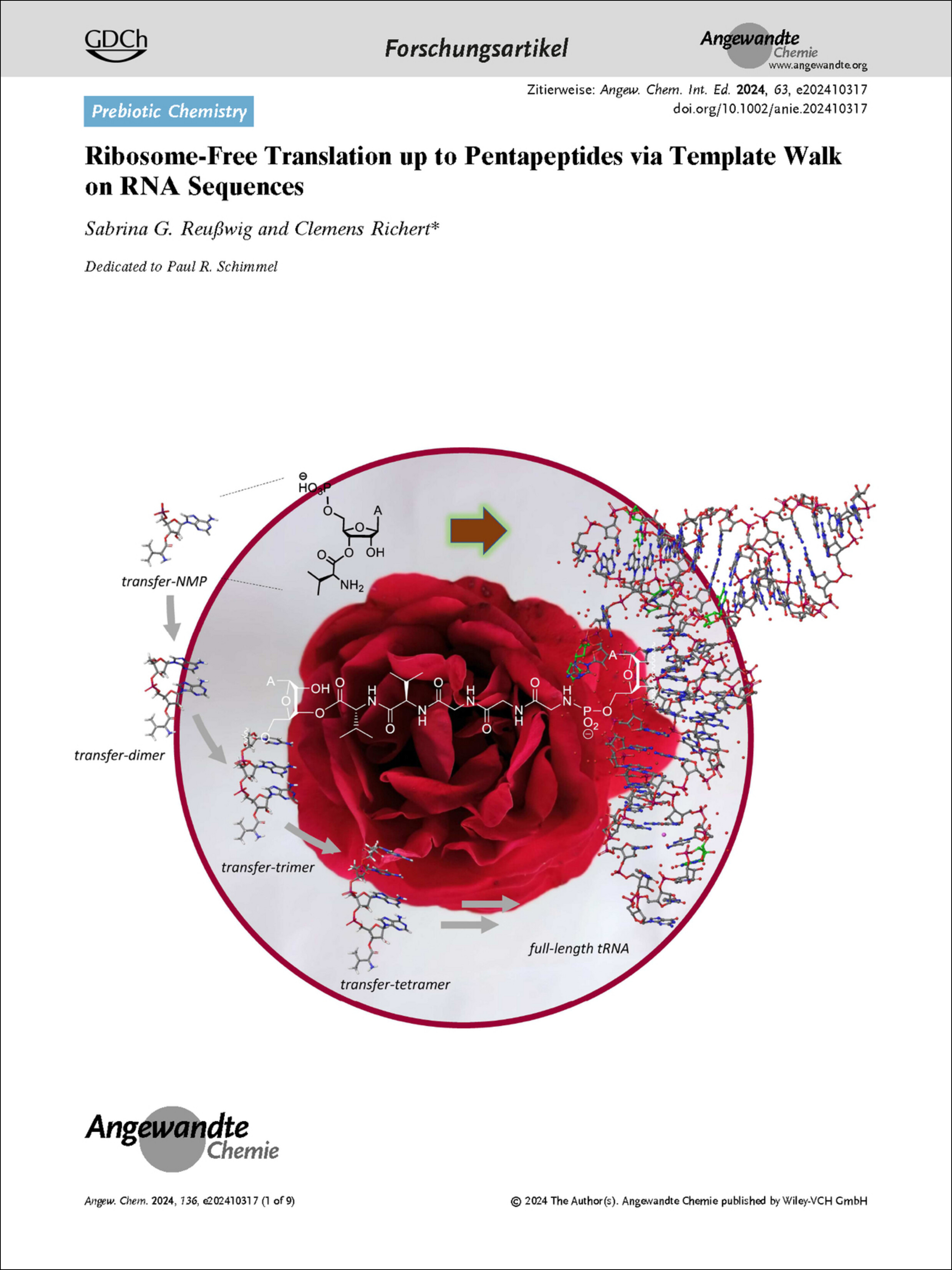
Peptides. In their Research Article (e202410317), Clemens Richert et al. describe the ribosome-free translation up to pentapeptides via template walk on RNA sequences.
Frontispiz: Artificial Mitochondria Nanoarchitectonics via a Supramolecular Assembled Microreactor Covered by ATP Synthase
- First Published: 12 September 2024
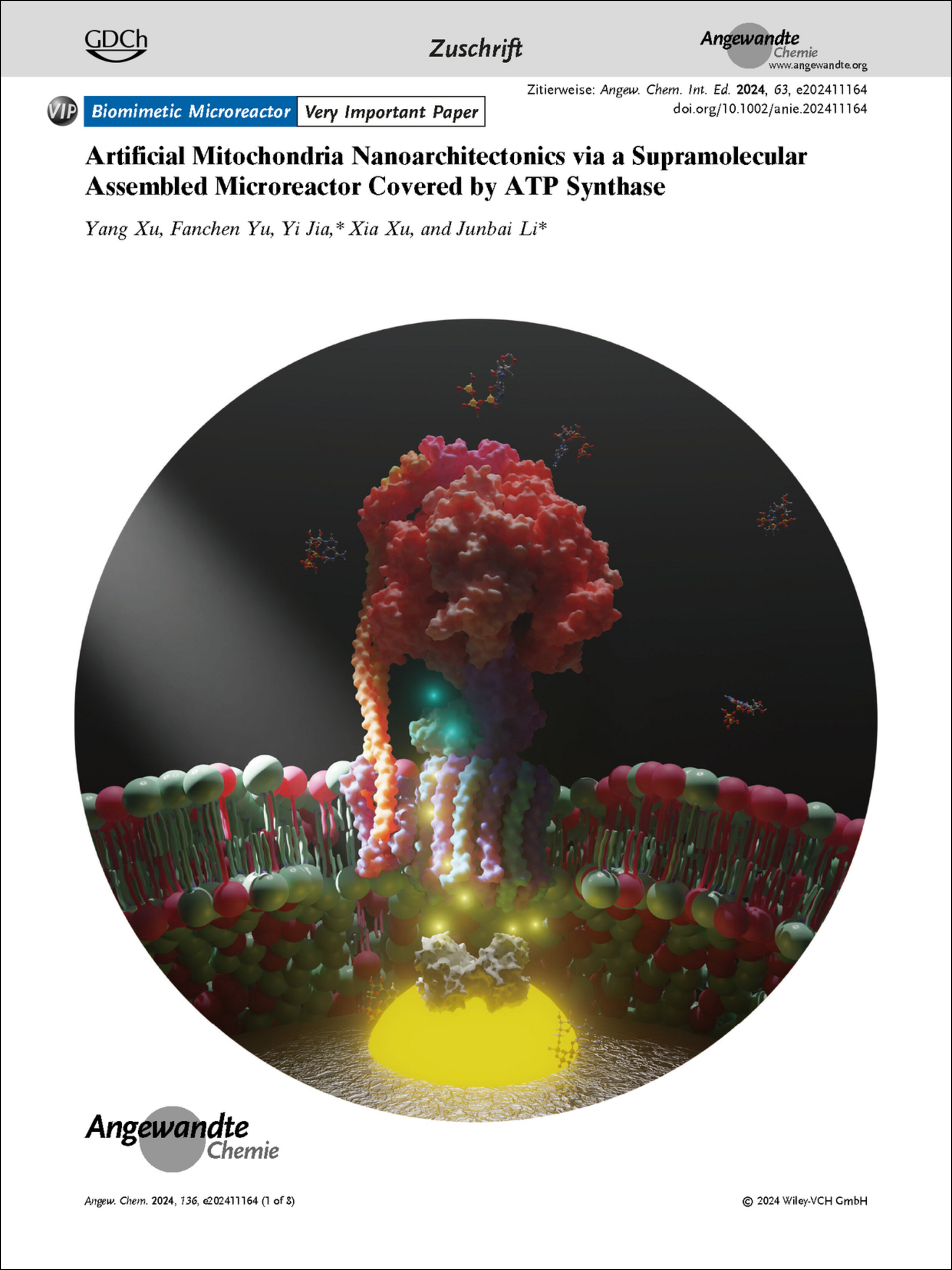
Biomaterials. In their Communication (e202411164), Yi Jia, Junbai Li et al. report the integration of natural acid phosphatase and ATP synthase with plasmonic Au clusters in a biomimetic microreactor.
Graphisches Inhaltsverzeichnis
Graphisches Inhaltsverzeichnis: Angew. Chem. 38/2024
- First Published: 12 September 2024
Announcement
Classifieds: Jobs and Awards, Products and Services
- First Published: 12 September 2024
Introducing …
Highlight
CO2 Reduction
Breakthrough in CO2 Electroreduction to Multi-Carbon Products at Ampere-Level Enabled by Active Sites Engineering
- First Published: 16 May 2024
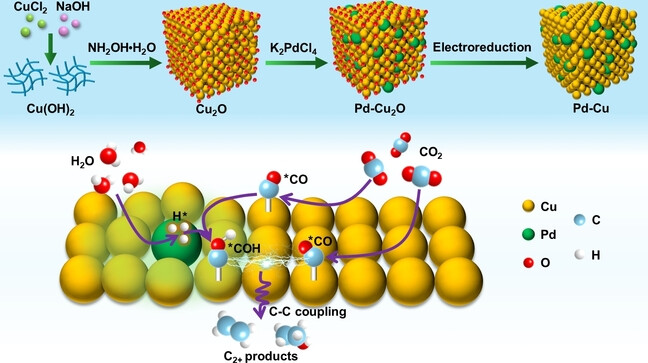
A novel electrocatalyst with three finely-tuned active sites was created by doping Pd atoms to Cu2O followed by a in situ electroreduction treatment, which can speed up the complex reactions of CO2 electroreduction to C2+ products in high FE and yield of C2+ products at ampere level current density.
Kurzaufsatz
Lanthanides
Aufsatz
Metal-Organic Frameworks
Metal–Organic Frameworks Derived Carbon-Supported Metal Electrocatalysts for Energy-Related Reduction Reactions
- First Published: 20 June 2024
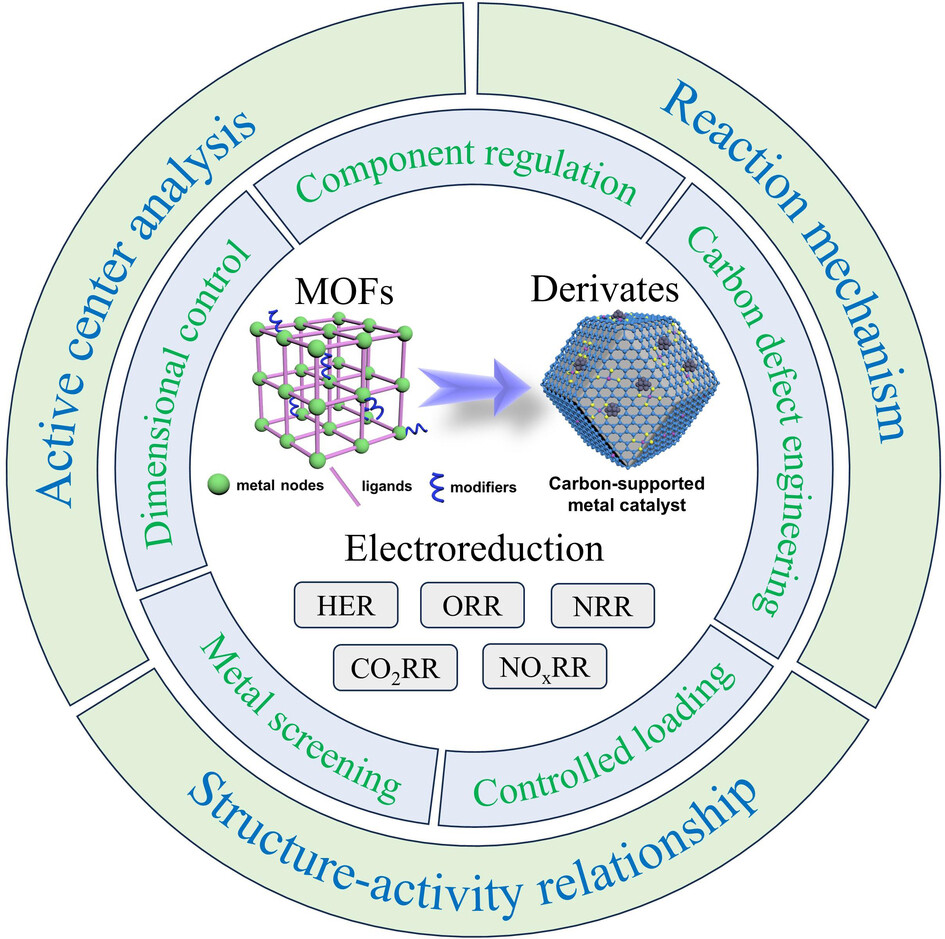
Recent advances on the different electroreduction applications of metal–organic framework derived carbon-supported metal electrocatalysts with customized structure, component, and electron structure are depicted. Thereout, morphology control, component/construction modulation and controlled metal loading strategies are systematically sorted out based on three key components of metal–organic frameworks, namely metal nodes, ligands and modifiers.
Forschungsartikel
Prebiotic Chemistry
Ribosome-Free Translation up to Pentapeptides via Template Walk on RNA Sequences
- First Published: 05 July 2024
Medicinal Chemistry | Very Important Paper
Photoswitchable Carbamazepine Analogs for Non-Invasive Neuroinhibition In Vivo
- First Published: 18 June 2024
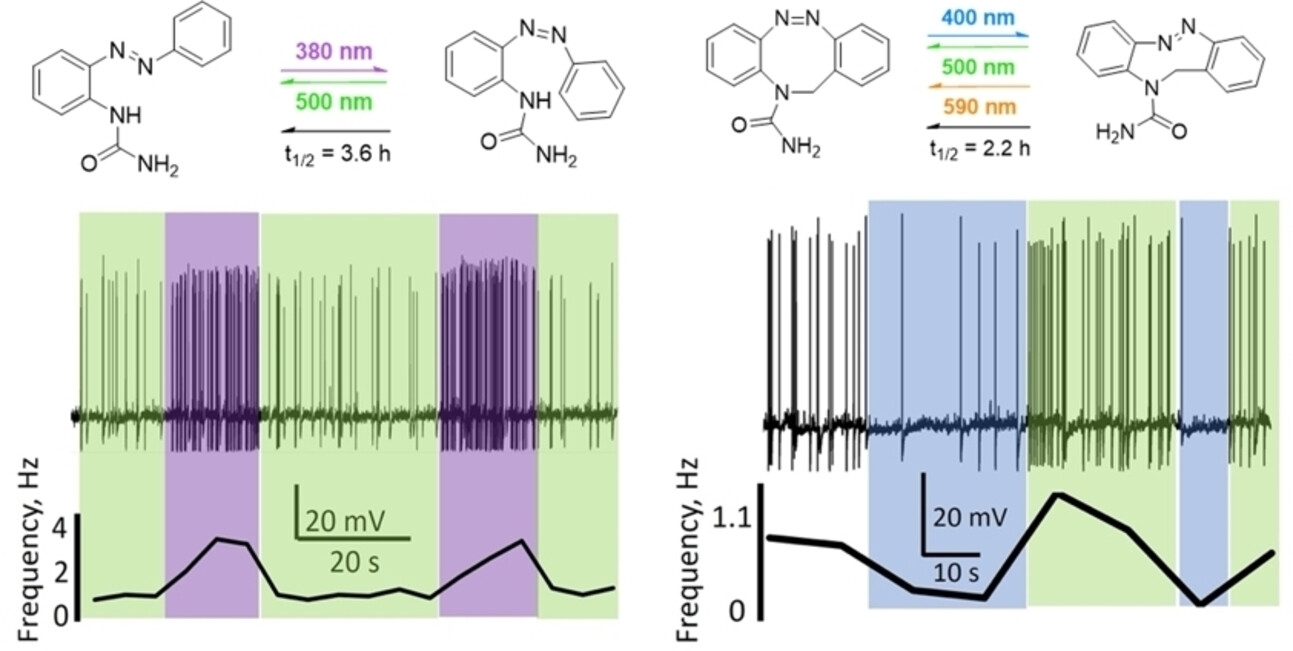
Photoswitchable derivatives of the antiseizure drug carbamazepine have been developed to inhibit nerve signals locally and on-demand using light. Two compounds allow controlling hippocampal neuron firing and zebrafish larvae locomotion with light, and Carbadiazocine (right) also offers in vivo analgesic efficacy in a rat model of neuropathic pain and a simple and compelling treatment demonstration with non-invasive illumination.
Dynamic Multicolor Fluorescence
Polymer Free Volume-Controlled Molecular Clock and Emitter for Multicolored Transient Data Display in Advanced Photonic Cryptography
- First Published: 26 June 2024
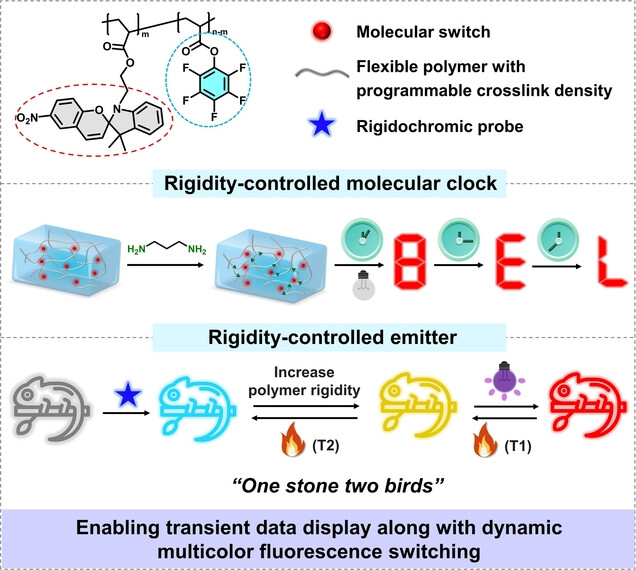
A versatile molecular clock and emitter consisting of pPFPA-co-SP and PTF1 has been developed via an “one stone (rigidity) two birds (clock and emitter)” strategy. Combining the synergistical responses of both pPFPA-co-SP and PTF1 toward the rigidity change of polymer network enables transient data display along with dynamic multicolor fluorescence switching, providing great potential for innovative applications from data security to display.
Na-S Batteries
Amorphous FeSnOx Nanosheets with Hierarchical Vacancies for Room-Temperature Sodium-Sulfur Batteries
- First Published: 24 May 2024
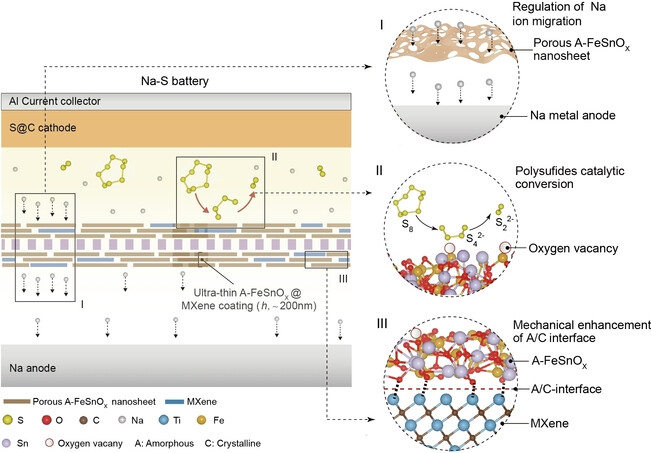
Amorphous 2D nanosheets with abundant nano-sized perforations and oxygen vancancies, mixed with a small amount of monolayer MXene, are coated on PP separators. This simultaneously regulates uniform Na deposition, facilitates the kinetics of polysulfides conversion, and enhances the mechanical properties.
Synthetic Methods | Hot Paper
Photochemistry
Directional Bias in Molecular Photogearing Evidenced by LED-Coupled Chiral Cryo-HPLC
- First Published: 03 July 2024
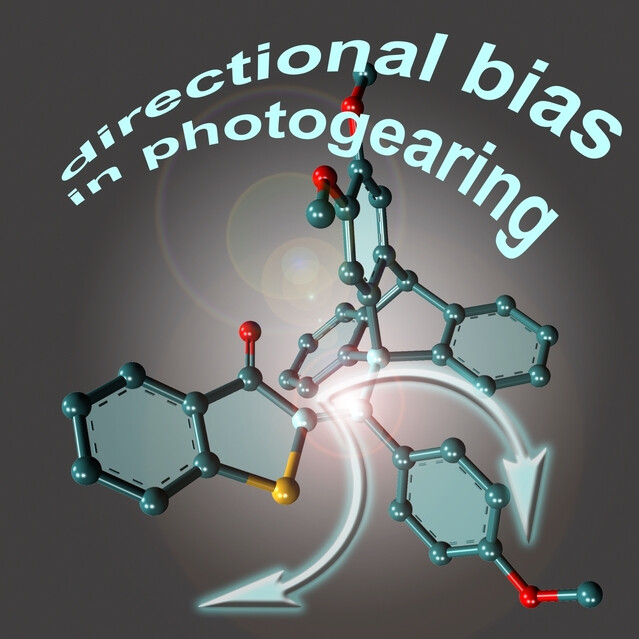
Significant directionality bias for the coupled rotations of a light-powered molecular photogear is evidenced by analysis of its enantiomeric states. Using a custom designed LED-coupled chiral cryo-HPLC setup, the sense of directionality of coupled double- and single bond rotations during photogearing could be elucidated directly. Electronic effects are found to be crucial for directionality bias instead of steric effects.
Batteries
A Conductive Binder Based on Mesoscopic Interpenetration with Polysulfides Capturing Skeleton and Redox Intermediates Network for Lithium Sulfur Batteries
- First Published: 30 June 2024
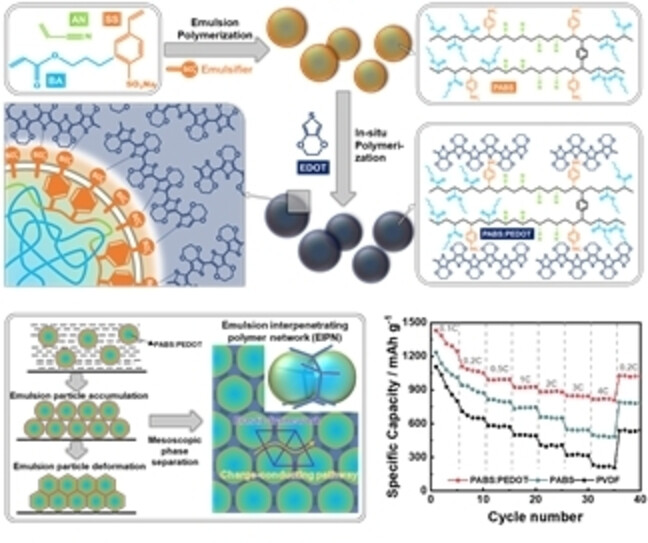
An aqueous conductive emulsion binder with the sulfonate-containing hard elastic copolymer core and the conjugate polymer shell capable of forming a bicontinuous mesoscopic interpenetrating network was synthesized. The lithium sulfur battery assembled with this binder has excellent electrochemical performance, especially rate performance and cycling stability.
Zn-S Batteries | Hot Paper
Synergistic Electrocatalysis and Spatial Nanoconfinement to Accelerate Sulfur Conversion Kinetics in Aqueous Zn−S Battery
- First Published: 23 June 2024
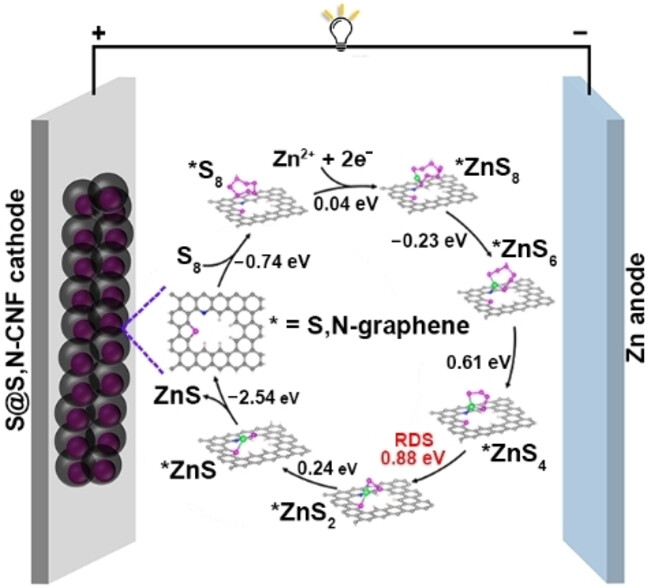
Sulfur/nitrogen dual-doped porous carbon nanofibers spatially confined sulfur nanoparticles (S@S,N−CNF) composite with yolk–shell sulfur@carbon nanostructure is elaborately fabricated. Benefiting from both the synergistic electrocatalysis and spatial nanoconfinement of S,N−CNF host, S@S,N−CNF cathode exhibits reduced energy barrier and accelerated sulfur reduction reaction kinetics enabling highly improved aqueous Zn−S battery performances.
Peptide Screening
mRNA Display in Cell Lysates Enables Identification of Cyclic Peptides Targeting the BRD3 Extraterminal Domain
- First Published: 20 June 2024
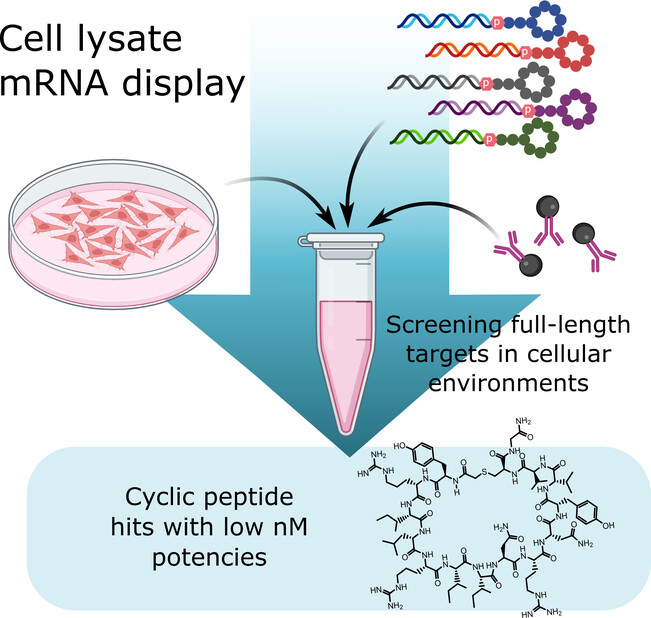
A method to perform mRNA display selections against protein targets expressed in mammalian cell lysates has been developed. This approach circumvents the need for purified proteins to be produced, giving access to targets that are aggregation-prone, contain disordered regions or that require post-translational modifications.
Synthetic Methods
Regio- and Diastereoselective Synthesis of Polysubstituted Piperidines Enabled by Boronyl Radical-Catalyzed (4+2) Cycloaddition
- First Published: 25 June 2024
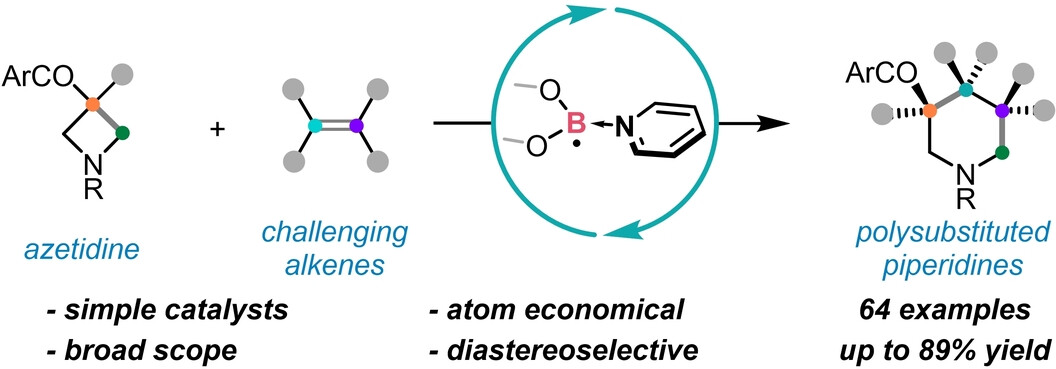
A boronyl radical-catalyzed intermolecular (4+2) cycloaddition reaction of azetidines with alkenes has been developed for efficient synthesis of 3,4,5-polysubstituted piperidines, which contain the medicinally relevant key heterocyclic motif and are not readily accessible by other methods. The reaction features high modularity, atom economy, simple operation, inexpensive non-metallic catalysts and broad substrate scope.
Potassium Dual-Ion Batteries
Unlocking Fast Potassium Ion Kinetics: High-Rate and Long-Life Potassium Dual-Ion Battery for Operation at −60 °C
- First Published: 20 June 2024
Nonlinear Optical Materials | Very Important Paper
Unlocking Giant Third-Order Optical Nonlinearity in (MA)2CuX4 through Introducing Jahn-Teller Distortion
- First Published: 24 May 2024
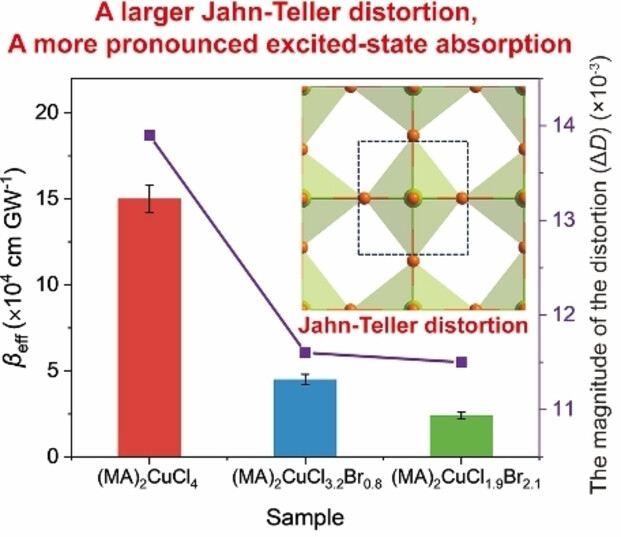
(MA)2CuX4 (MA=methylammonium; X=Cl, Br) leads to giant nonlinear absorption coefficients and substantial modulation depth. These performance improvements are correlated with the specific alignment of metal d bands and ligand p band in the Mott-Hubbard compound, and a larger p-d transition probability to d-d transition probability associated with the Jahn–Teller distortion.
Zinc-Ion Batteries
Entropy-Driven Hydrated Eutectic Electrolytes with Diverse Solvation Configurations for All-Temperature Zn-ion Batteries
- First Published: 29 June 2024
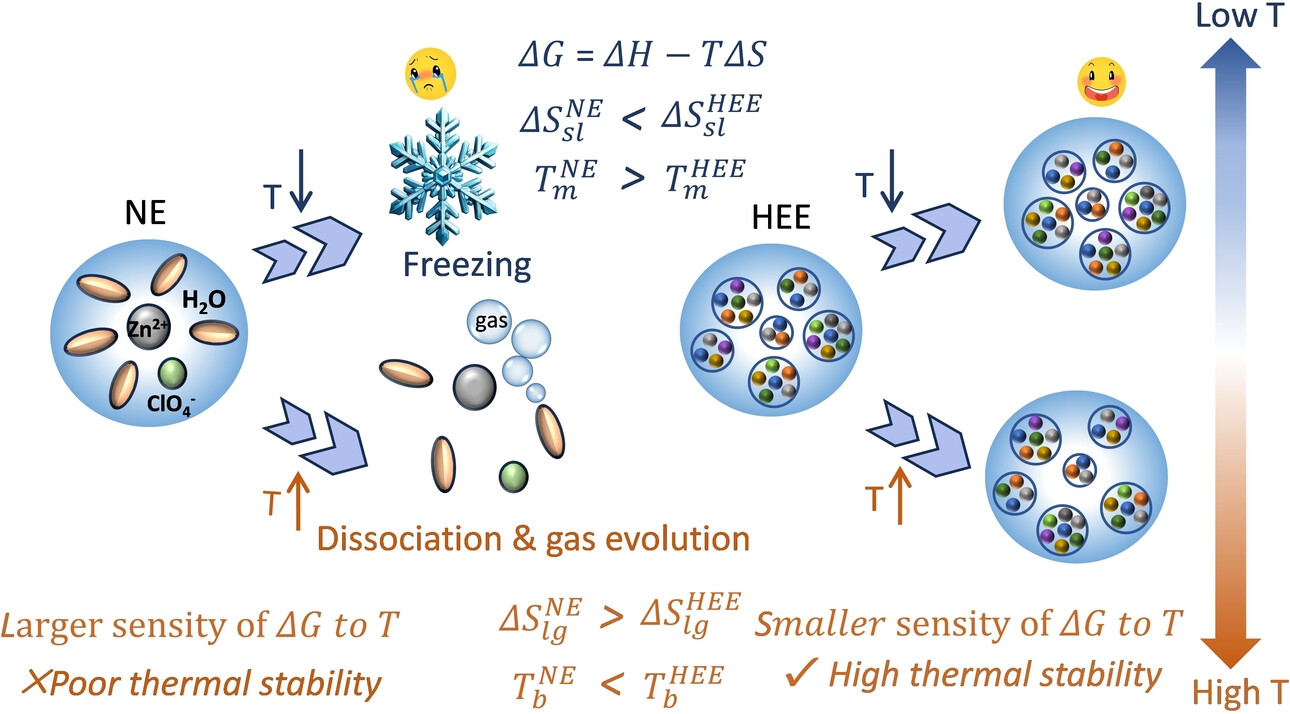
A new concept of entropy-driven hydrated eutectic electrolytes (HEE) with abundant solvation configurations are proposed for all-temperature Zn-ion batteries. The diverse and uniform solvation structures distribution enables the HEE possess much higher solvation configurational entropy than conventional aqueous electrolytes, leading to its superior anti-freezing ability and high thermal stability.
Agonist
piSTING: A Pocket-Independent Agonist Based on Multivalency-Driven STING Oligomerization
- First Published: 20 May 2024
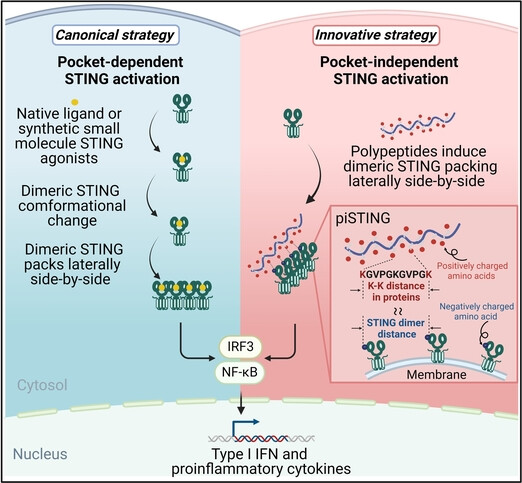
We developed novel pocket-independent STING-activating agonists (piSTINGs), which act through multivalency-driven oligomerization to activate downstream signalling pathways. piSTINGs could serve as novel STING agonists for vaccines and combination therapies. And STING oligomerization is a useful strategy for the development of a new generation of STING agonists.
Electrosynthesis
Nickel-Catalyzed Electrochemical Cross-Electrophile C(sp2)−C(sp3) Coupling via a NiII Aryl Amido Intermediate
- First Published: 07 June 2024
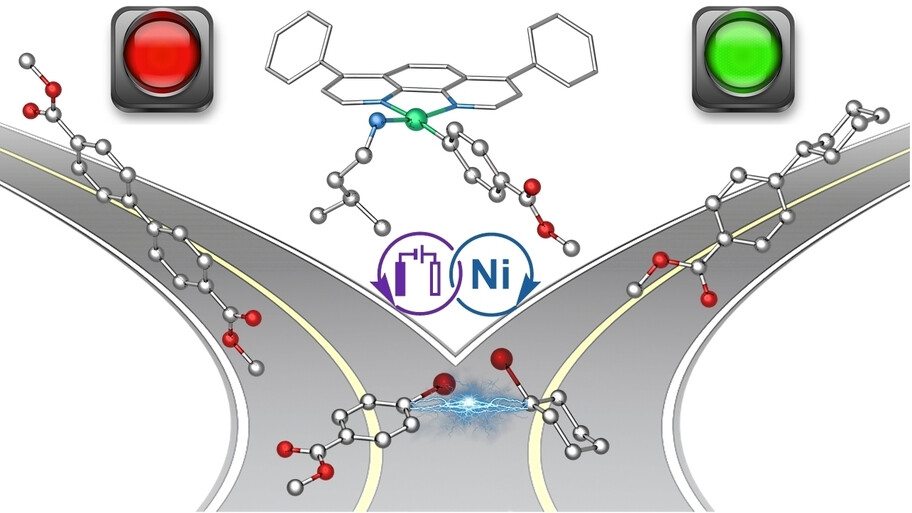
A highly selective and scalable Ni-catalyzed electrochemical Cross-Electrophile (XEC) reaction between (hetero)aryl halides and primary and secondary alkyl halides was achieved via an in situ generated NiII aryl amido intermediate. The NiII aryl amido intermediate stabilizes the NiII–aryl species to prevent the aryl–aryl homo-coupling side reactions and acts as a catalyst to activate the alkyl bromide substrates.
Biocatalysis | Very Important Paper
Stereodivergent Total Synthesis of Tacaman Alkaloids
- First Published: 01 July 2024
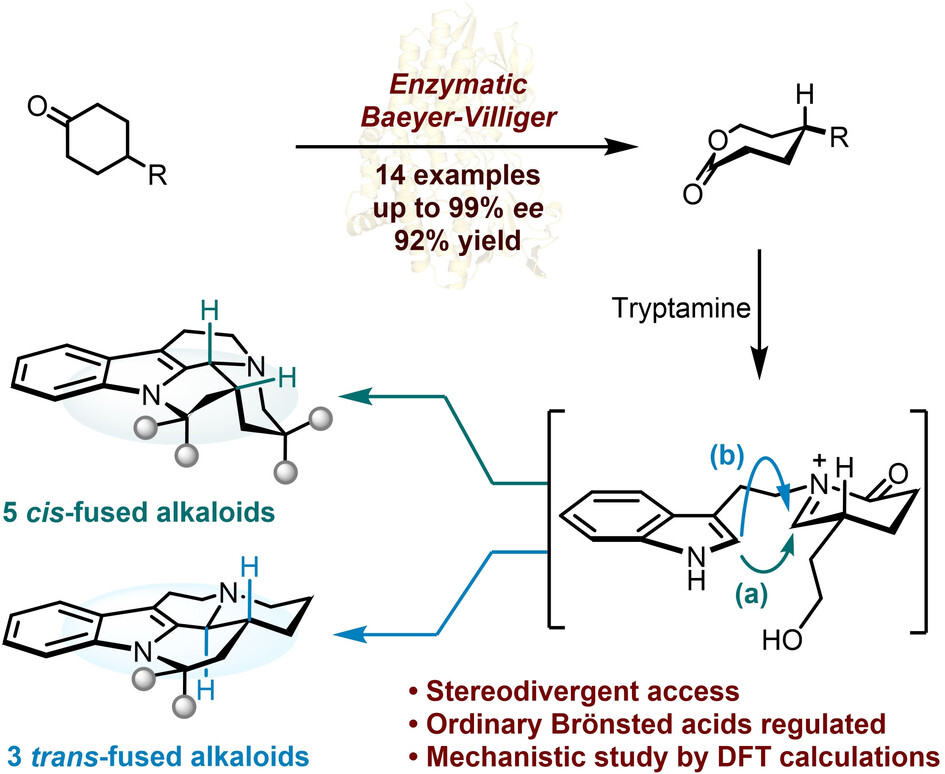
The asymmetric total synthesis of eight tacaman alkaloids was accomplished. A chemoenzymatic Baeyer–Villiger reaction was used to produce seven-membered lactones, establishing a stereogenic center at the C14 position. Acid-regulated cyclization cascades involving the Pictet–Spengler reaction afforded cis- and trans-fused tetracyclic cores. DFT calculations indicated that the stereochemistry of this cascade was controlled via hydrogen bonding.
Main-Group Chemistry
Alkene Isomerisation Catalysed by a Superbasic Sodium Amide
- First Published: 17 June 2024

Using superbasic sodium amide NaTMP as a catalyst, isomerisation of alkenes at room temperature under mild condition has been accomplished. Isolation of organometallic intermediates and DFT calculations have revealed the key role on TMP(H), acting as a proton source and facilitatitng the migration of the double bond.
G-quadruplex
Discovery of A G-Quadruplex Unwinder That Unleashes the Translation of G-Quadruplex-Containing mRNA without Inducing DNA Damage
- First Published: 02 July 2024
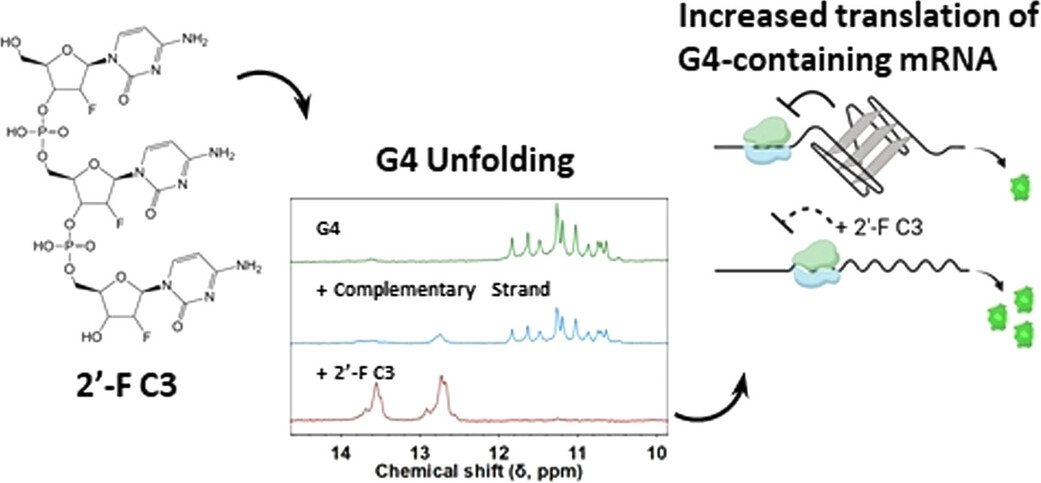
We discovered a G4 unwinder, 2′-F C3, capable of promoting the unwinding of both DNA and RNA G4 structures. In living cells, 2′-F C3 does not induce severe DNA damage at a concentration below 10 μM, nor does it broadly interfere with G4-related biological processes. Specially, it can enhance the translation level of G4-containing mRNA.
Hydrogen Evolution
Electrosynthesis of an Improbable Directly Bonded Phosphorene-Fullerene Heterodimensional Hybrid toward Boosted Photocatalytic Hydrogen Evolution
- First Published: 17 June 2024
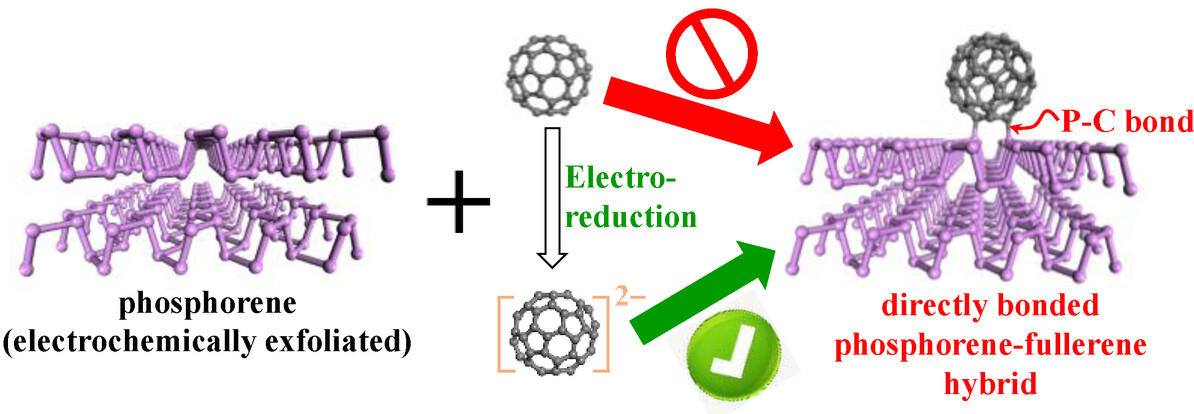
Phosphorene-fullerene hybrid with fullerene directly bonded onto the surface (basal plane) of phosphorene via P−C bonds was theoretically predicted “improbable” due to the strong repulsion between phosphorene and neutral fullerene.It is now synthesized by an electrosynthesis method involving C602− dianion as an intermediate generated by electroreduction of C60, significantly improving the stability and visible light/near-infrared (NIR) photocatalytic hydrogen evolution rates of phosphorene.
Na-Ion Batteries | Hot Paper
Reconstructing Helmholtz Plane Enables Robust F-Rich Interface for Long-Life and High-Safe Sodium-Ion Batteries
- First Published: 04 July 2024
Electrocatalysis | Very Important Paper
Hydrogen Spillover Mechanism at the Metal–Metal Interface in Electrocatalytic Hydrogenation
- First Published: 03 July 2024
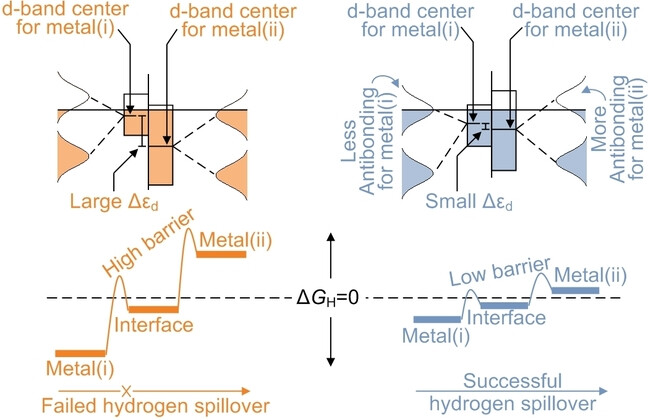
At the metal–metal interface, the minimized difference in the d-band center between these metals (Δϵd) reduces the free energy difference between hydrogen adsorption on metal(i) and metal(ii) and lower the kinetic barrier to hydrogen spillover between them. As a result, it can achieve a record high electrocatalytic nitrate hydrogenation efficiency at low energy consumption.
MOFs for Anesthetic Regeneration | Very Important Paper
Exhaled Anesthetic Xenon Regeneration by Gas Separation Using a Metal–Organic Framework with Sorbent-Sorbate Induced-Fit
- First Published: 02 July 2024
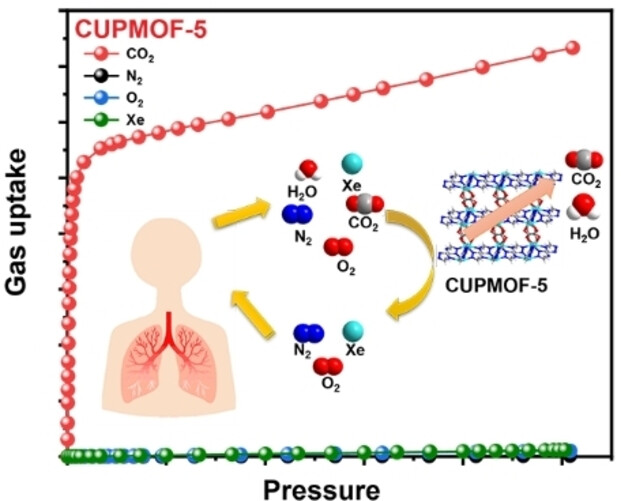
CUPMOF-5, an efficient CO2-specific adsorbent to be used in a closed-circuit Xe recovery process, offers a promising solution to Xenon scarcity in medicine. With exceptional molecular sieving capabilities confirmed via SCXRD and simulations, CUPMOF-5 achieves an outstanding 99.8 % Xe recovery rate by dynamic breakthrough experiments, making it ideal for online CO2 removal and Xe recovery in anesthetic circuits.
Organic Solar Cells
Fully Fused Indacenodithiophene-Centered Small-Molecule n-Type Semiconductors for High-Performance Organic Electronics
- First Published: 03 July 2024

Two n-type organic semiconductors featured with fully fused structure has been synthesized by a newly developed strategy to generate high-performance organic field-effect transistors and organic solar cells. The properties of these new organic semiconductors were systematically investigated and elucidated experimentally.
Natural Products | Hot Paper
Total Syntheses of Streptamidine and Klebsazolicin Using Biomimetic On-Resin Ring-Closing Amidine Formation
- First Published: 24 June 2024
Zinc-Ion Batteries | Hot Paper
Carbon Superstructure-Supported Half-Metallic V2O3 Nanospheres for High-Efficiency Photorechargeable Zinc Ion Batteries
- First Published: 26 June 2024
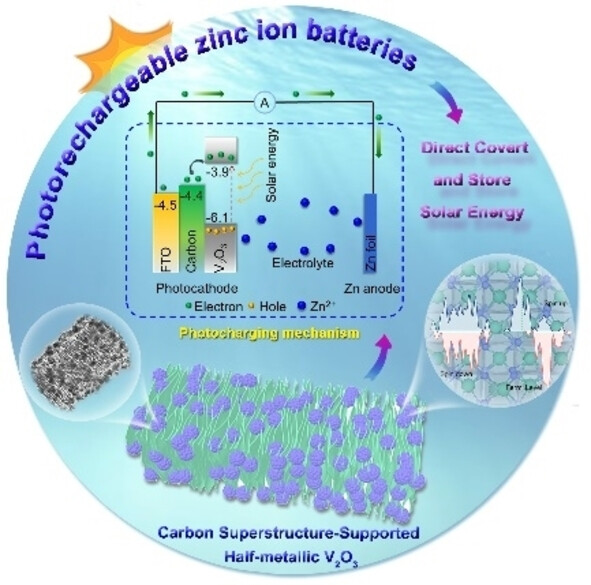
Half-metallic V2O3 was firstly reported as a dual-functional photocathode for PZlBs. The half-metallic V2O3, combined with the three-dimensional superstructure assembled by carbon nanosheets, established rapid charge transfer networks and robust framework. Consequently, the V2O3@CSs photo cathode delivered record zinc ion storage and photo rechargeable properties. This study offered a promising direction for the capture and storage of solar energy.
Covalent Organic Frameworks | Hot Paper
Ionic Liquid-Accelerated Growth of Covalent Organic Frameworks with Tunable Layer-Stacking
- First Published: 28 June 2024

In this study, we devised a novel approach termed “key-cylinder lock mimic” to fabricate seven staggered stacking Covalent Organic Frameworks (COFs). This method leverages ionic liquids as both solvents and mediators, operating under mild conditions. Through meticulous selection, ionic liquids possessing appropriate molecular volumes and symmetric bipolar functional groups were identified as pivotal elements in manifesting the confined interlocking effect and steric hindrance essential for the synthesis of staggered stacking COFs.
Janus Heterostructures | Hot Paper
All-in-One: Plasmonic Janus Heterostructures for Efficient Cooperative Photoredox Catalysis
- First Published: 03 July 2024
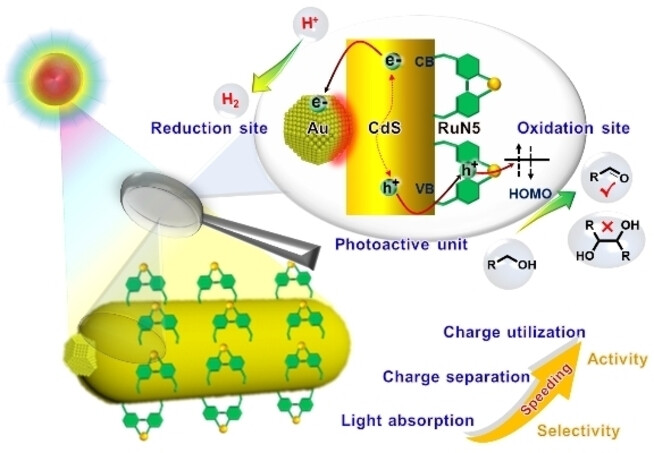
We report the design of a reduction co-catalyst-tipped and oxidation co-catalyst-capped Janus heterostructure, which reveals the benefits of efficient interfacial charge separation via transfer of photogenerated electrons and holes, respectively, to Au and RuN5 sites for selective organic synthesis and H2 production via photoredox paired reaction coupling.
Nonlinear Opitics | Hot Paper
Remarkable Second Harmonic Generation Response in (C5H6NO)+(CH3SO3)−: Unraveling the Role of Hydrogen Bond in Thermal Driven Nonlinear Optical Switch
- First Published: 10 June 2024
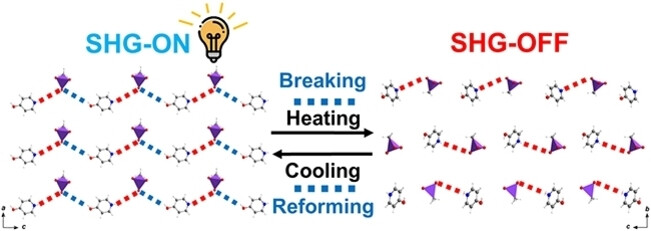
We report a novel material (C5H6NO)+(CH3SO3)− (4HPMS), exhibiting the strongest second harmonic generation (SHG) intensity among all heat-stimulated nonlinear optical (NLO) switches. We unravel an unprecedently easier breaking of the shorter hydrogen bond and a rare large thermal hysteresis of 50 °C during the reversible structural phase transition.
Polymer Chemistry | Hot Paper
Self-Adaptive Synthesis of Non-Covalent Crosslinkers while Folding Single-Chain Polymers
- First Published: 29 June 2024

Dynamic combinatorial macrocyclic disulfides acted as non-covalent crosslinkers, adapting to polymer folding. Initially, small macrocycles fold the polymer into a loose state, which then catalysed the formation of larger macrocycles to enhance folding efficiency. Our work deepens the understanding of interplay between adaptive synthesis and dynamic folding, advancing the strategy for replicating protein folding into functional nanoparticles.
Thermally Activated Delayed Fluorescence | Hot Paper
Linearly Arranged Multi-π-Stacked Structure for Efficient Through-Space Charge-Transfer Emitters
- First Published: 04 July 2024
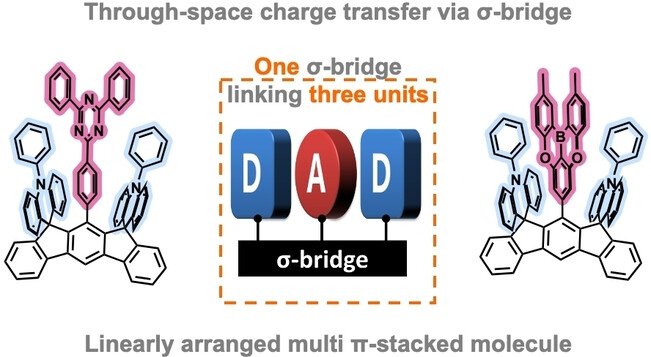
Through-space charge-transfer materials excel in organic light-emitting diodes, with π-stacked structures being effective frameworks, but the lack of robust construction methods hinders progress. Double C−H activation has now been used to construct two donor-acceptor-donor (D|A|D) type through-space charge-transfer materials derived from C11-substituted indenofluorene skeletons, with maximum external quantum efficiencies of 28.6 % and 16.2 % achieved.
Heterogeneous Catalysis | Very Important Paper
Full Selectivity Control over the Catalytic Hydrogenation of Nitroaromatics Into Six Products
- First Published: 26 June 2024
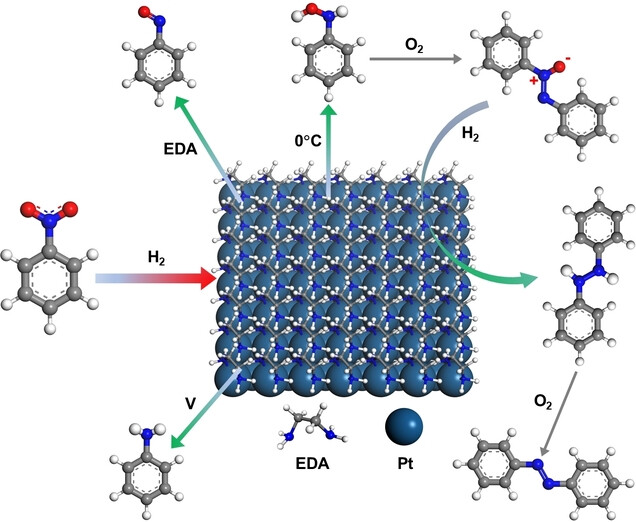
A single catalytic system has been developed for the production of six products, namely nitroso, hydroxylamine, azoxy, azo, hydrazo and aniline compounds, from nitroaromatics. Furthermore, a detailed reaction network for the catalytic hydrogenation of nitroaromatics has been constructed based on systematic investigation into the controlled production of all products and their chemical reactivities via oxygen-isolated characterisation techniques.
Electrochemistry | Hot Paper
Paired Electrolysis Enables Reductive Heck Coupling of Unactivated (Hetero)Aryl Halides and Alkenes
- First Published: 20 June 2024
High-Performance Adhesives
Asynchronous Ring Opening of Cyclic Carbonate and Glycidyl Ether Induced Phase Evolution Towards Heat-Free and Rapid-Bonding Superior Epoxy Adhesive
- First Published: 26 June 2024
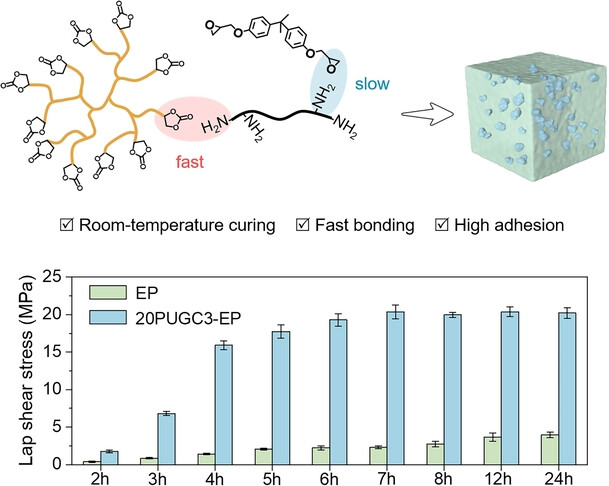
A highly-branched polyurethane capped by cyclic carbonate was reported to perform asynchronous crosslinking with epoxy. The distinctive ring opening kinetics between the cyclic carbonate and epoxide groups, combined with a moderate branching degree, result in unique phase evolution. This process effectively toughens the adhesive and rapidly increases shear strength at room temperature to a level suitable for structural bonding.
Aqueous Batteries | Hot Paper
Confining Conversion Chemistry in Intercalation Host for Aqueous Batteries
- First Published: 22 June 2024
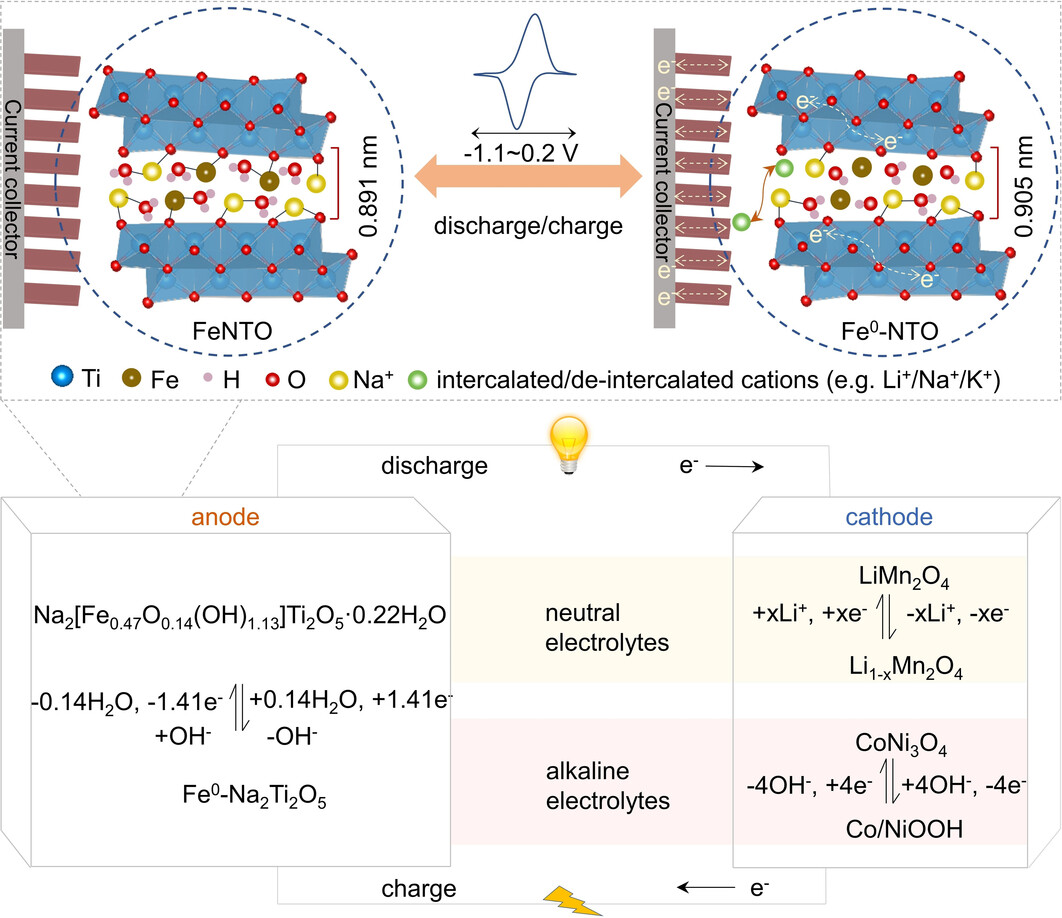
Confining conversion chemistry in intercalation host enables an integrated anode structure of iron oxide/hydroxide-pillared titanate. The iron-based conversion reaction is spatially and kinetically confined within sub-nano interlayer of titanate, achieving long cycle life, fast kinetics, and universal generality to the electrolyte medium. Two unique types of full batteries are further assembled, exhibiting low redox polarization and long cycling stability.
Covalent Organic Frameworks | Hot Paper
Piezofluorochromism in Covalent Organic Frameworks: Pressure-Induced Emission Enhancement and Blue-Shifted Emission
- First Published: 24 June 2024
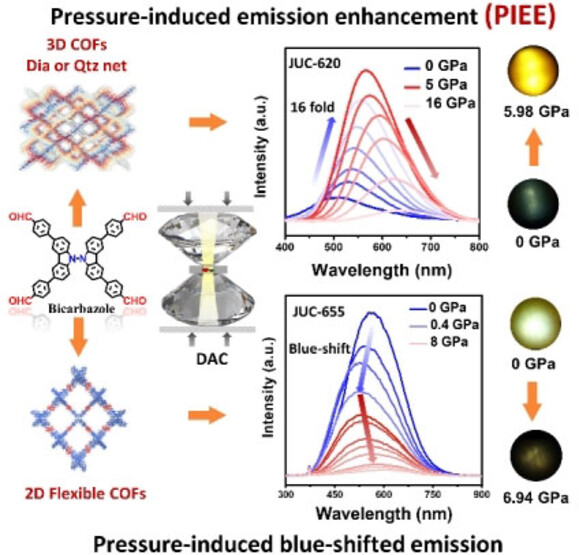
A range of 2D and 3D bicarbazole-based COFs with varying dimensions, topologies, and linkages were employed to systematically investigate their piezochromic behavior, revealing significant pressure-induced emission enhancement with an increase of 16-fold, as well as rare instances of blue-shifted emission.
Nitrate Reduction
Coordination Desymmetrization of Copper Single-Atom Catalyst for Efficient Nitrate Reduction
- First Published: 08 August 2024
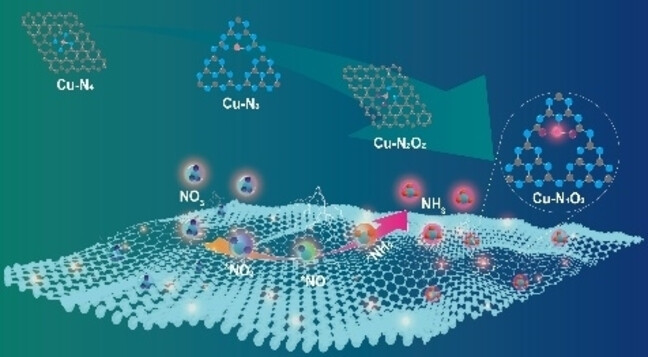
We demonstrate that asymmetric coordination of single-atom copper catalysts can greatly enhance the efficiency and stability of NO3RR catalysis, which attributes to the accumulation of NO3− on the surface and the reduction of the energy barrier regarding the formation of the key reaction intermediate.
Sodium-Ion Batteries
Unexpected Elevated Working Voltage by Na+/Vacancy Ordering and Stabilized Sodium-Ion Storage by Transition-Metal Honeycomb Ordering
- First Published: 24 June 2024
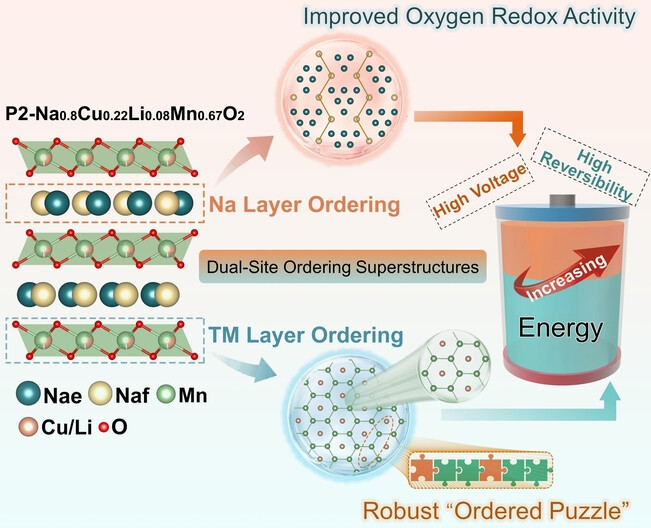
The layered oxide cathode material featuring dual-site ordering superstructures is prepared by simply regulating the calcination time, where the optimized Na+/vacancy ordering significantly elevates the operating voltage and the transition-metal honeycomb ordering effectively stabilizes the structure, leading to the increased energy density and high cycling stability in sodium-ion batteries.
Nitrate Reduction Reaction | Very Important Paper
Polymer Chemistry | Very Important Paper
Closed-Loop Recyclable Poly(ester-disulfide)s for Potential Alternatives to Engineering Plastic
- First Published: 21 June 2024

It is a representative case study of tough, chemical resistant and closed-loop recyclable dynamic poly(ester-disulfide)s of which their highly crosslinking nature was contributed by a synergetic effect of covalent ester-bond linkages and non-covalent hydrogen bonding, metal-ligand coordinations, subsequently endowing the fabricated optical-transparent materials with excellent mechanical properties, decent chemical resistance and facile closed-loop recycling capabilities, comparable with engineering polymers.
Molecular Sieving
Crystalline Porous Organic Cage Membranes Constructed Using Fortified Intermolecular Interactions for Molecular Sieving
- First Published: 25 June 2024
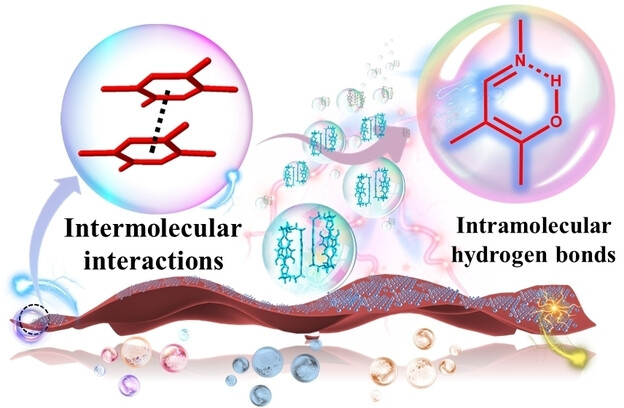
A series of imine-linked crystalline free-standing porous organic cage (POC) membranes were constructed via interfacial polymerization at room temperature and atmospheric pressure conditions for molecular sieving. The crystalline POC membranes were fabricated by fortifying intermolecular interactions through the induction of intramolecular hydrogen bonds.
Photocatalysis | Hot Paper
Tandem Proton Transfer in Carboxylated Supramolecular Polymer for Highly Efficient Overall Photosynthesis of Hydrogen Peroxide
- First Published: 03 July 2024
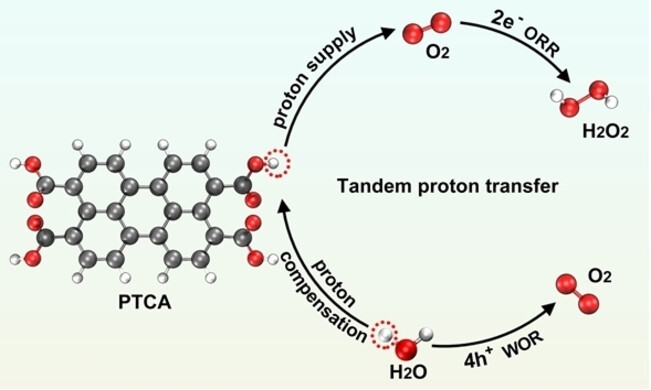
Carboxyl-enriched supramolecular polymer (perylene tetracarboxylic acid—PTCA) has been elaborately prepared. The efficient tandem proton transfer process remarkably facilitates 2e− ORR to synthesize H2O2 and in the meanwhile promotes 4e− WOR to evolve O2. As expected, the catalyst realizes outstanding H2O2 yield in air and even argon atmospheres without any sacrificial reagents.
Organic Synthesis
Axial Ligand Enables Synthesis of Allenylsilane through Dirhodium(II) Catalysis
- First Published: 18 June 2024

An ON-OFF effect of amine ligand enabled Rh2(II)-catalyzed SN2′-type silylation of propargyl ester bearing a terminal alkyne moiety using hydrosilane was achieved. The fine-tuning effect of the tertiary amine is crucial in the improvement of reactivity. The tertiary amine plays a significant role in assisting the formation of the Rh−Si species via a concerted metalation deprotonation (CMD) mechanism and facilitating β-oxygen elimination.
Metal-Organic Frameworks
A Stable Site-Isolated Mono(phosphine)-Rhodium Catalyst on a Metal-Organic Layer for Highly Efficient Hydrogenation Reactions
- First Published: 25 June 2024
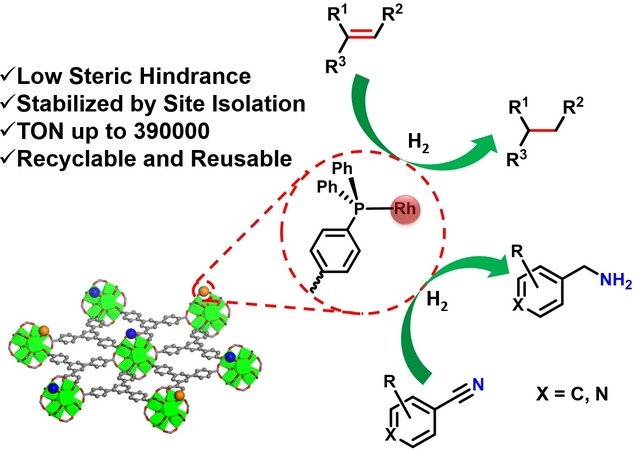
The synthesis of a highly efficient and reusable metal-organic layer (MOL) catalyst is described. The stable site-isolated mono(phosphine)-rhodium complex on the MOL exhibits high catalytic efficiency in the hydrogenation of mono-, di-, and tri-substituted alkenes and the reduction of nitriles to primary amines with turnover numbers of up to 390000 due to the lowering of reaction energy barriers by the low steric hindrance of catalytic active sites.
Host-Guest Systems | Hot Paper
Single-Crystal Cage Framework with High Selectivity and Reversibility in Fullerene Binding
- First Published: 30 June 2024
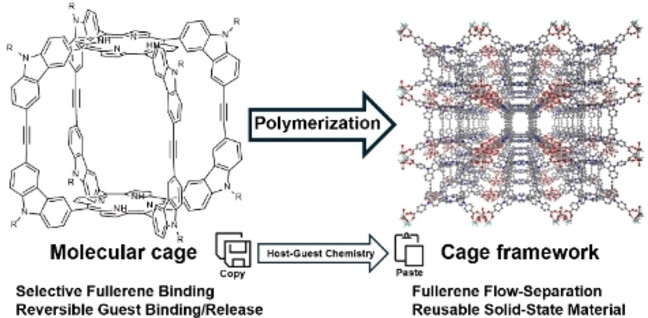
Single-crystal porous frameworks were constructed from shape-persistent molecular cage building blocks and unambiguously characterized by single-crystal X-ray diffraction. The resulting framework showed a high fullerene binding capacity, fast binding kinetics, and a high C60/C70 binding selectivity. The host–guest binding interaction can be turned on and off by treatment with weak acid/base, which enabled the high-efficiency flow-separation of fullerene mixtures.
Lithium-Metal Batteries | Very Important Paper
In Situ Analysis of Interfacial Morphological and Chemical Evolution in All-Solid-State Lithium-Metal Batteries
- First Published: 30 June 2024

Using complementary in situ characterizations including atomic force microscopy and X-ray photoelectron spectroscopy, we directly detected morphological/chemical evolution, Li plating/stripping processes and SEI dynamics in all-solid-state Li-metal batteries. Furthermore, Li-ion field distribution at the interface between different solid-state electrolytes was successfully visualized by Kelvin probe force microscopy.
Photochemistry
Visible-Light-Mediated Activation of Remote C(sp3)−H Bonds by Carbon-Centered Biradical via Intramolecular 1,5- or 1,6-Hydrogen Atom Transfer
- First Published: 20 June 2024

This study unveils novel intramolecular HAT reactions that produce azetidine, oxetane, and indoline derivatives. Facilitated by excited triplet-state carbon-centered biradicals, this process enables the 1,5-HAT reaction by suppressing the Norrish Type II cleavage reaction. It also pioneers unprecedented 1,6-HAT reactions initiated by excited triplet-state alkenes. Comprehensive experiments and DFT calculations support all findings.
Coordination Polymers
The Use of Photocycloaddition Reactions to Drive Mechanical Motions Resembling Humanoid Movements
- First Published: 18 June 2024
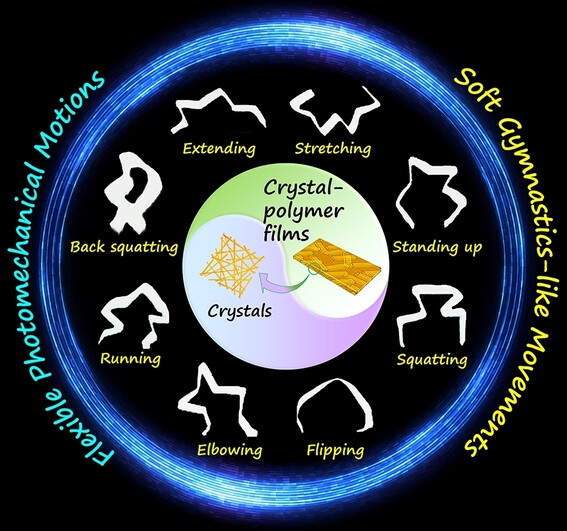
A crystalline molecular material with olefinic groups has been used to achieve photomechanical motion in both single crystals and single-crystal composite films. This dimerization of dipyridyl ligands by [2+2] photocycloaddition introduces strain within the crystal, resulting in a variety of fast, flexible and continuous photomechanical including reversible bending and curling, movements that resemble a human performing various gymnastic exercises.
Noncovalent Interactions
π-Diamond: A Diamondoid Superstructure Driven by π-Interactions
- First Published: 19 June 2024
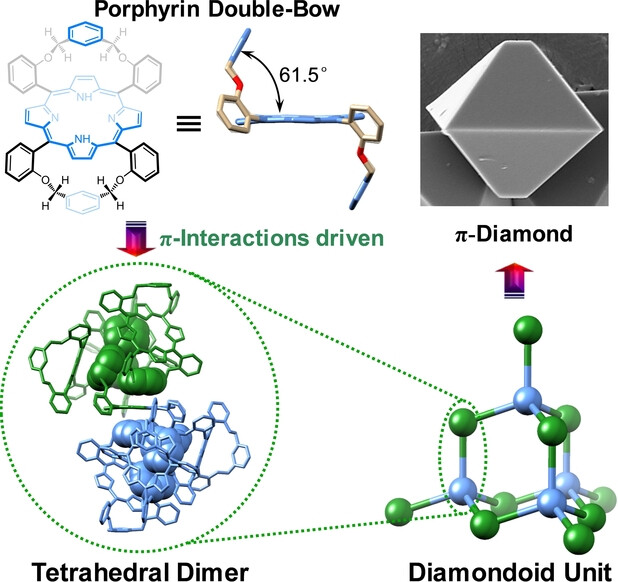
We created a 3D diamondoid superstructure called π-Diamond using a strained Z-shaped building block with a porphyrin unit and two m-xylylene units. It resembles diamond's structure and is driven purely by π-interactions. Hetero-π-stacking assembles four building blocks into an extendable double-walled tetrahedron, forming an adamantane unit and the diamondoid superstructure.
CO2 Reduction
Lattice Strain Engineering Boosts CO2 Electroreduction to C2+ Products
- First Published: 01 July 2024
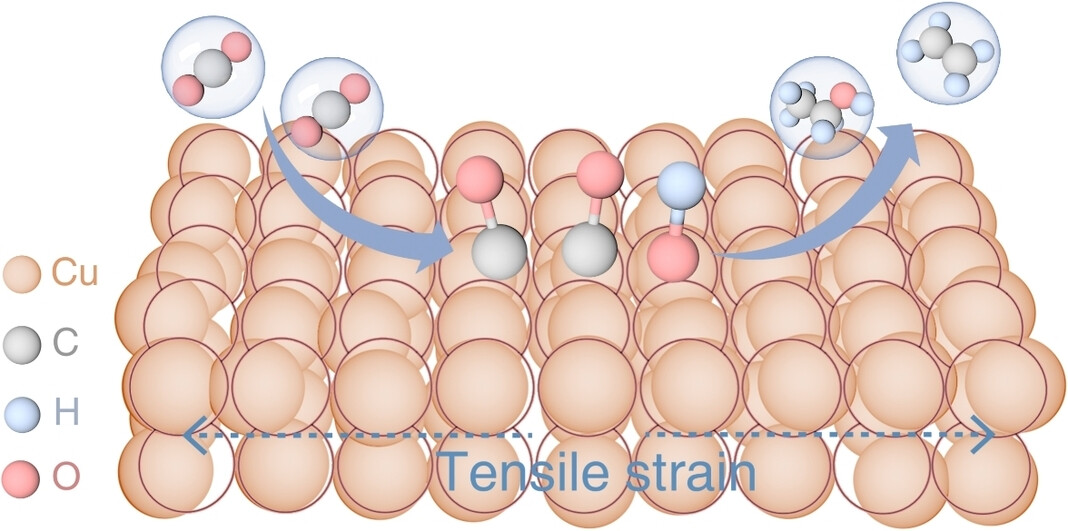
A strategy for preparing Cu catalyst with varying lattice tensile strain but without introducing additional components was proposed and confirmed to be effectively for inhibiting the dipole–dipole repulsion between *CO species and enhancing the adsorption of the *OH species, simultaneously. The CuTPA catalyst with large tensile strain achieves a high FEC2+ of 90.9 % and a partial current density of 486.1 mA cm−2 in CO2RR with excellent stability.
Organic Light-Emitting Diodes | Hot Paper
Regional Functionalization Molecular Design Strategy: A Key to Enhancing the Efficiency of Multi-Resonance OLEDs
- First Published: 05 July 2024
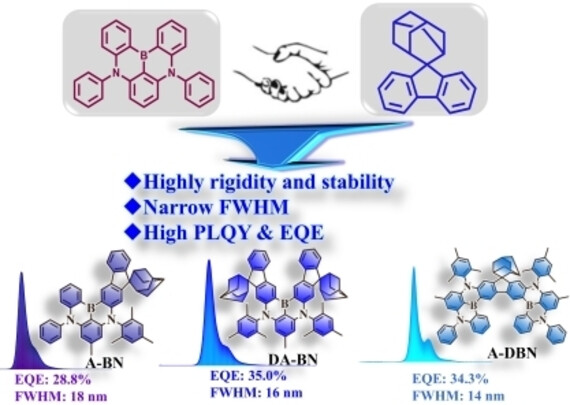
The regional functionalization molecular design strategy that enables independent control of distinct pivotal parameters through distinct segments of the molecule. The proof-of-concept molecule A-DBN has not only attained a minimal FWHM of 14 nm but has also realized nearly 100 % photoluminescence quantum yield.
Supramolecular Interactions
From Coordination to π-Hole Chemistry of Transition Metals: Metalloporphyrins as a Case of Study
- First Published: 27 June 2024
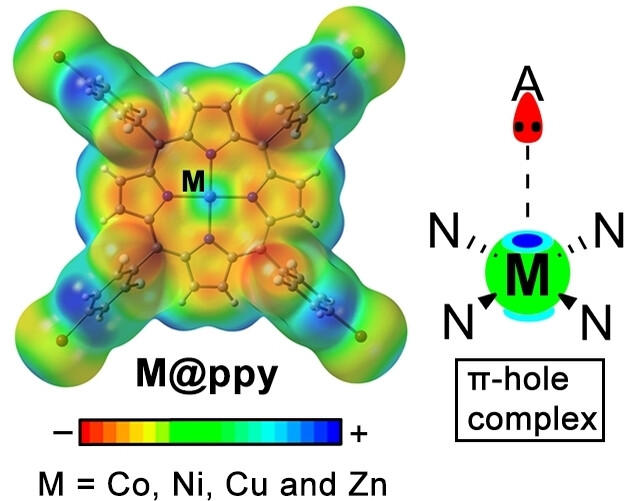
In this combined experimental (X-ray structure analysis) and computational (DFT-D3 calculations) study we have systematically evaluated the π-hole donor ability of elements across Groups 9 to 12 using metalated porphyrins (ppys) as model systems. The results obtained will make impact in the fields supramolecular chemistry, crystal engineering and catalysis, where noncovalent Lewis Base⋅⋅⋅Metal interactions play a crucial role.
H2O2-Erzeugung | Hot Paper
Anodische H2O2-Erzeugung in Elektrolyten auf Karbonatbasis – Mechanistische Erkenntnisse Mittels Elektrochemischer Rastermikroskopie
- First Published: 24 June 2024
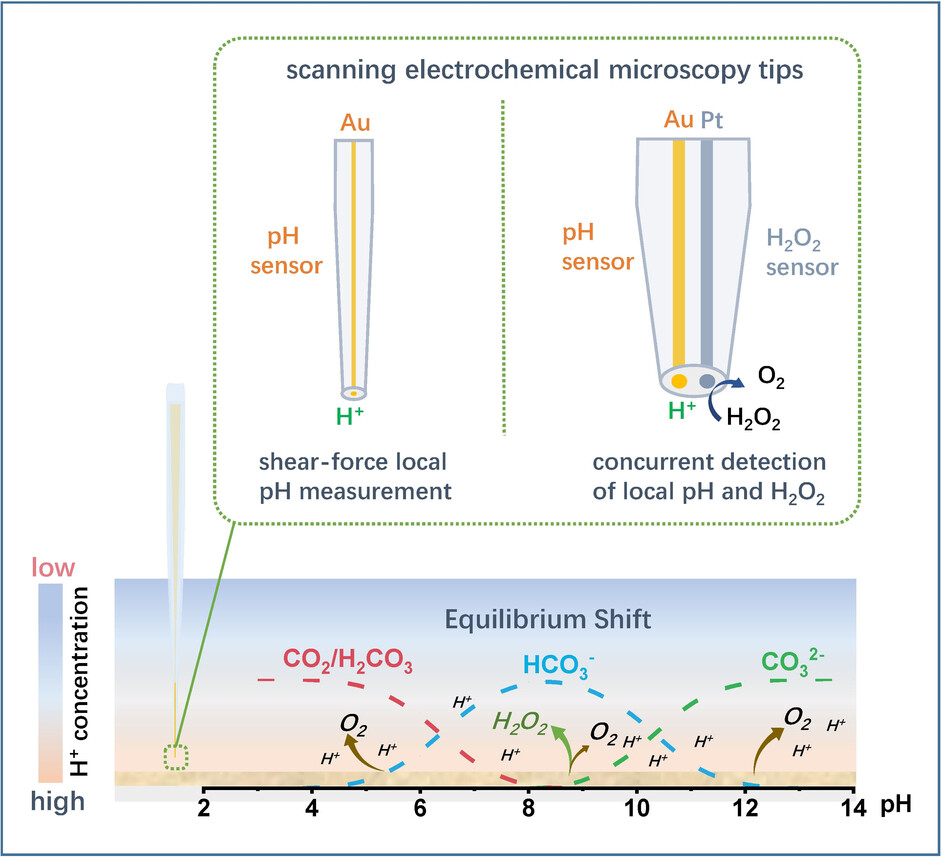
Die lokale pH-Messung zeigt, dass das bestimmende Anion an der Grenzfläche HCO3− ist, und zwar bei Potentialen, bei denen H2O2 bevorzugt gebildet wird, unabhängig vom pH-Wert des Hauptelektrolyten. Eine Au−Pt-Doppelzylinder-Mikroelektrode zeigt, dass die lokale HCO3−-Konzentration insgesamt durch den Oxidationsstrom, die Pufferkapazität und den pH-Wert des Gesamtelektrolyten bestimmt wird.
Polymerchemie
Aluminiumalkylinduzierte Isomerisierung von Gruppe IV meso Metallocen Komplexen
- First Published: 07 July 2024

Methoxysubstituenten von Gruppe IV meso Metallocenkomplexen ermöglichen deren Aluminiumalkyl (TIBA/TMA) induzierte Isomerisierung. Die meso Isomere galten bisher als nutzlos und mussten mühsam getrennt werden, wenn die rac Analoga zur Polymerisation von Propylen eingesetzt wurden. Durch die Isomerisierung wird die Ausbeute an isotaktischem Polypropylen um 400 % erhöht; ein Mechanismus wird postuliert.
Enzymkatalyse
Ein funktioneller Wechsel zwischen Asperfumen- und Fusicoccadien-Synthase und Eintritt in die Asperfumen-Biosynthese durch einen vicinalen Deprotonierungs-Reprotonierungsprozess
- First Published: 01 July 2024
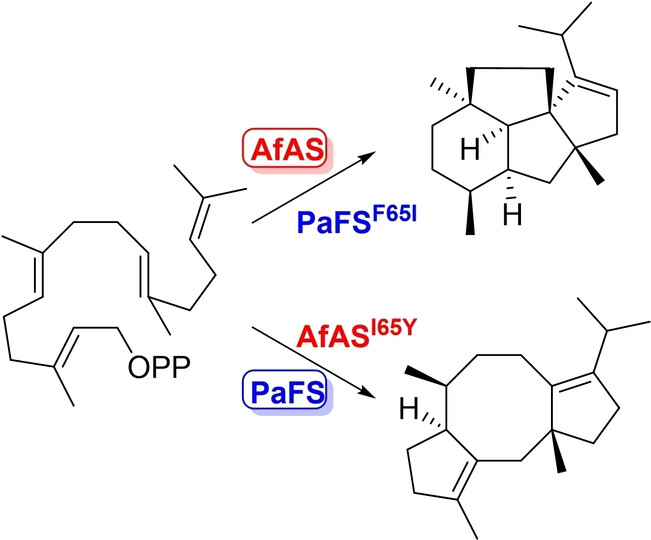
Die Diterpensynthase AfAS aus Aspergillus fumigatiaffinis produziert Asperfumen mit einem neuartigen 6–5–5–5 tetracyclischen Gerüst. Dessen Cyclisierungsmechanismus wurde durch Isotopenmarkierungsexperimente und DFT-Rechnungen untersucht. Durch ortsspezifische Mutageneseexperimente wurde der Rest 65 als entscheidender Schalter für die Bildung von Asperfumen oder strukturell einfacheren Diterpenen mit einem tricyclischen 5–8–5-Gerüst entdeckt.
ZIF-Gläser | Hot Paper
Einblicke in die Mechanochemische Glasbildung von Zeolithischen Imidazolat-Gerüstverbindungen
- First Published: 14 June 2024
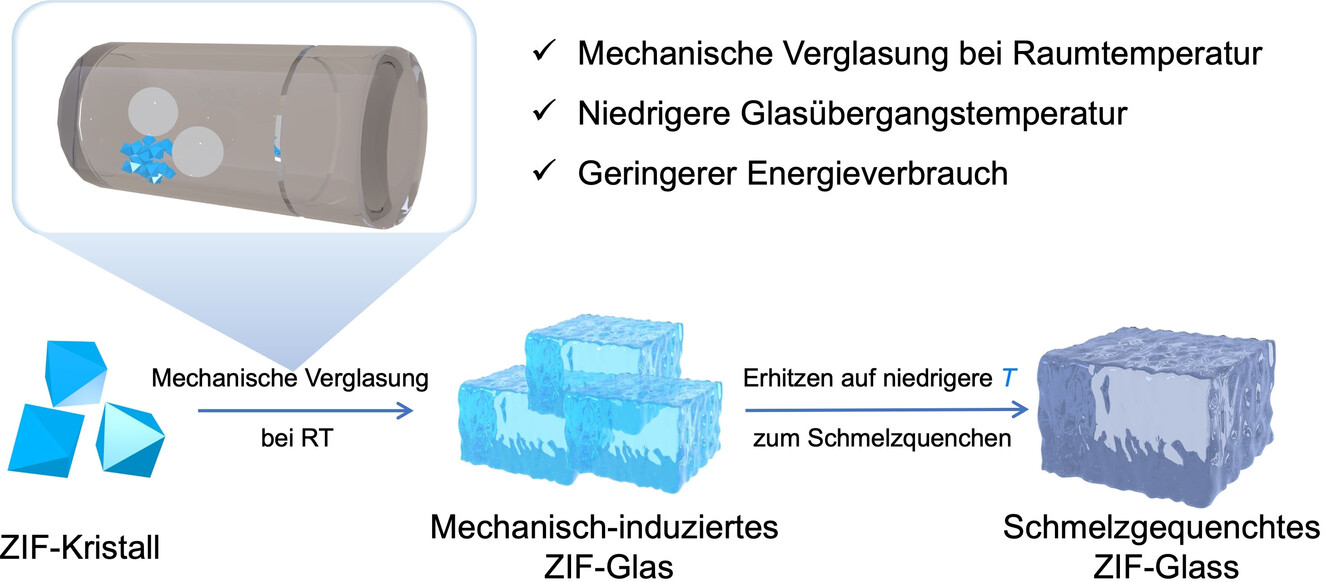
Kugelmahlen wird für die direkte Verglasung von diversen zeolithischen Imidazolat-Gerüstverbindungen (ZIFs) bei Raumtemperatur angewandt, was durch die Herstellung des ersten ZIF-Glases auf Basis von Cu2+ hervorgehoben wird. Diese Forschungsarbeit leistet einen wichtigen Beitrag zur Erweiterung des derzeit begrenzten Zusammensetzungsbereichs von MOF-Gläsern.
Zuschrift
Biomimetic Microreactor | Very Important Paper
Artificial Mitochondria Nanoarchitectonics via a Supramolecular Assembled Microreactor Covered by ATP Synthase
- First Published: 25 June 2024

ATP synthesis against abiotic stress is achieved by biomimetic assembly microreactor based on phosphatase/Au clusters and ATP Synthase. Phosphatase is harnessed to generate both protons and Pi to support the synthesis of ATP under phosphorus-deficiency stress. Au clusters in the microreactor help proteins resist the destruction from ROS, and concurrently facilitate the photothermal-enhanced ATP synthesis.
One-Dimensional Wires
Aggregation of One-Dimensional Wires: The Case of Long Oligoynes
- First Published: 27 June 2024
Asymmetric Catalysis
Enantioselective Construction of Tetrahydroindole Skeletons by Rh-Catalyzed [2+2+2] Cycloaddition of Homopropargyl Enamides with Alkynes
- First Published: 26 June 2024
![Enantioselective Construction of Tetrahydroindole Skeletons by Rh-Catalyzed [2+2+2] Cycloaddition of Homopropargyl Enamides with Alkynes](/cms/asset/33f05dc0-3e93-4706-a7e3-ee36ea954f0e/ange202404310-toc-0001-m.jpg)
A cationic rhodium(I)/axially chiral biaryl bisphosphine complex catalyzes the [2+2+2] cycloaddition of homopropargyl enamides with alkynes at room temperature to construct tetrahydroindole skeletons found in natural alkaloids and pharmaceuticals with high yields and regio- and enantioselectivity. In this cycloaddition, the substituents of the enynes change the ratio of intramolecular and intermolecular rhodacycle formation when using terminal alkynes, varying the ee values of the cycloadducts.
Ring Expansion
Streamlining the Synthesis of Pyridones through Oxidative Amination of Cyclopentenones
- First Published: 27 June 2024
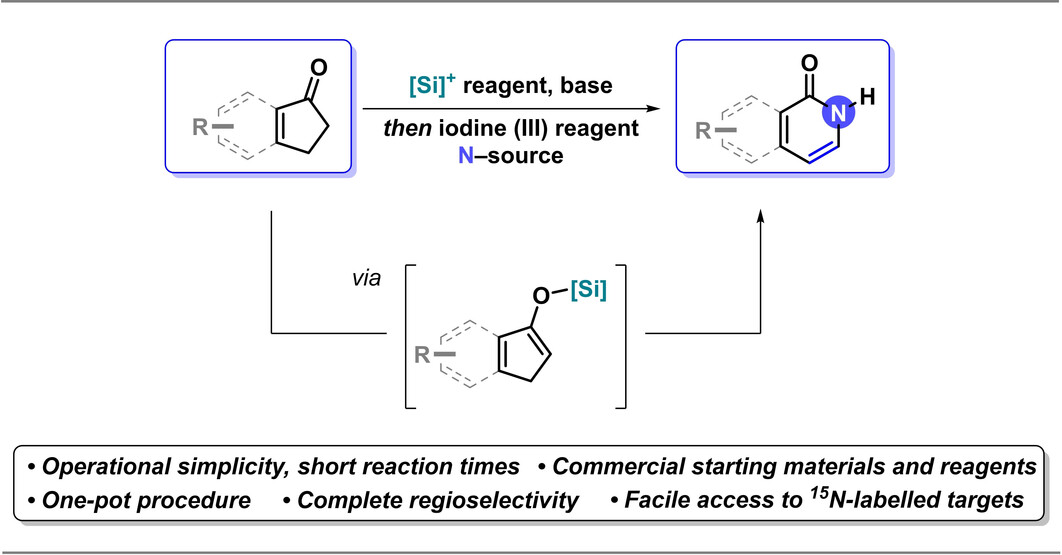
An oxidative amination process enables the streamlined synthesis of pyridones. Cyclopentenone building blocks undergo silyl enol ether formation, followed by nitrogen atom insertion and aromatisation to yield pyridones. The developed one-pot reaction is mild, operationally simple, exhibits broad functional group tolerance and complete regioselectivity, and provides facile access to 15N-labelled targets.
Electrosynthesis
Asymmetric Paired Electrolysis: Enantioselective Alkylation of Sulfonylimines via C(sp3)−H Functionalization
- First Published: 03 July 2024
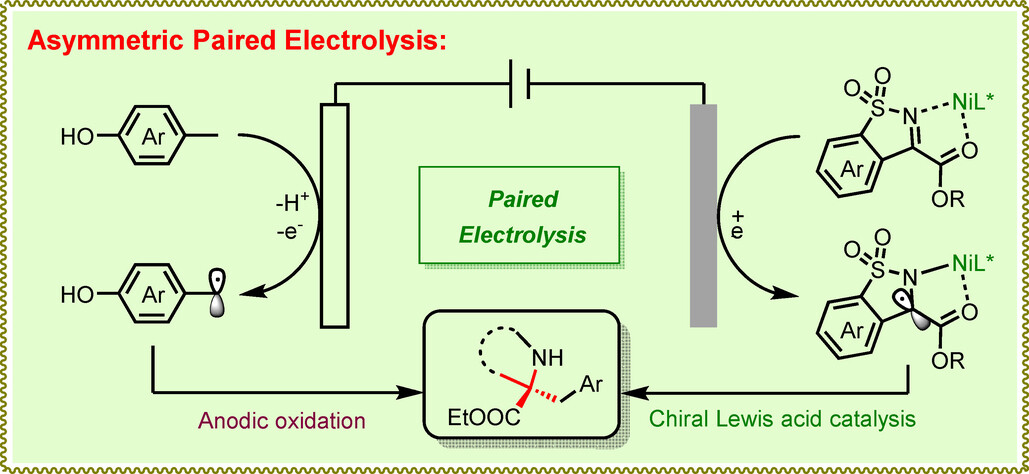
An asymmetric paired electrolysis strategy for alkylation of sulfonylimines is reported. Anodic oxidation for benzylic radical formation and Lewis acid-catalyzed sulfonylimine reduction on the cathode are seamlessly cross-coupled using this protocol, providing enantio-enriched chiral amines containing a tetrasubstituted carbon stereocenter with high enantioselectivity under mild conditions.
Refractive Crystals | Hot Paper
Breaking Boundaries: Giant Ultraviolet Birefringence in Dimension-Reduced Zn-Based Crystals
- First Published: 26 June 2024
Synthetic Methods
The Modular Synthesis of Sulfondiimidoyl Fluorides and their Application to Sulfondiimidamide and Sulfondiimine Synthesis
- First Published: 26 June 2024
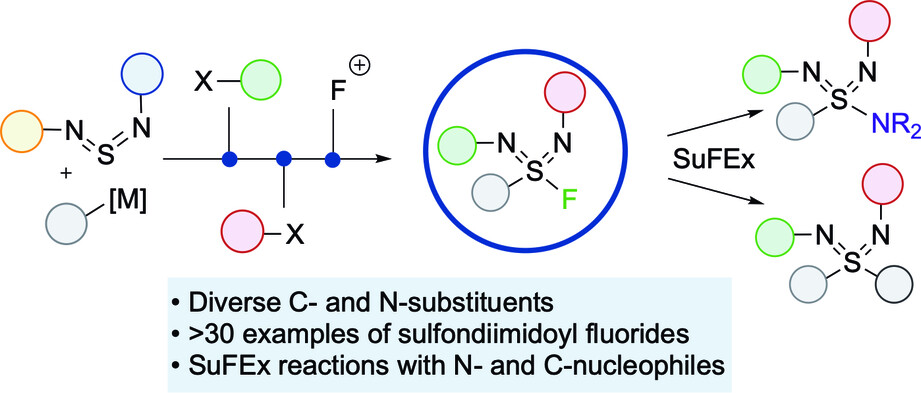
Combining organometallic reagents with sulfurdiimide reagents, simple electrophiles, and then an electrophilic fluorine reagent provides a modular and scalable synthesis of sulfondiimidoyl fluorides. For the first time it is possible to prepare these unique functional groups with broad flexibility at the carbon and both imidic nitrogen atoms. SuFEx reactivity using amines and organolithium reagents is demonstrated, leading to sulfondiimidamide and sulfondiimine products.
Pentaphyrin Chemistry
5,18-Dimesitylorangarin: a Stable Antiaromatic [20]Pentaphyrin(1.0.1.0.0) Displaying Remarkable Oxidative Self-Coupling Reactions
- First Published: 05 July 2024
![5,18-Dimesitylorangarin: a Stable Antiaromatic [20]Pentaphyrin(1.0.1.0.0) Displaying Remarkable Oxidative Self-Coupling Reactions](/cms/asset/70192f00-d5d2-47a6-ae10-8175fe3090a1/ange202409655-toc-0001-m.jpg)
5,18-Dimesitylorangarin and its BF2 complex were synthesized as the first example of meso-aryl-substituted orangarins by double SNAr reaction of 3,5-dibromo-BODIPY with 2-pyrrolydipyrrin. These orangarins are antiaromatic but stable. Remarkable oxidative self-coupling reactivities of the orangarin and its oligomers were demonstrated up to triply-COT-centered orangarin tetramers. COT-centered 3H-orangarin oligomers are oxidized to the corresponding 2H-orangarin oligomers, which show effective conjugation across the COT bridge. These directly linked orangarin oligomers show many reversible redox potentials owing to the intramolecular electronic interaction.
Fluorescent Materials
Structural Fine-Tuning to Achieve Highly Fluorescent Organic and Water-Soluble Thiazolo[5,4-d]thiazole Chromophores
- First Published: 02 July 2024
![Structural Fine-Tuning to Achieve Highly Fluorescent Organic and Water-Soluble Thiazolo[5,4-d]thiazole Chromophores](/cms/asset/607875ea-2c1d-4a4d-ae01-4479c3de07a6/ange202409725-toc-0001-m.jpg)
Unsymmetrical donor-thiazolothiazole-acceptor systems exhibit high solution state fluorescence quantum yield in polar organic solvents and water via intramolecular charge-transfer (ICT). Computational studies reveal that; i) thiazolothiazole bridge is non-innocent and can act as a donor or acceptor, and ii) the ICT is best captured by a fragment-based approach in which the change in charges between the excited and ground state is examined.
Supramolecular Chemistry
3D-Printing Multi-Component Multi-Domain Supramolecular Gels with Differential Conductivity
- First Published: 27 June 2024
Proton Batteries | Very Important Paper
Realization of Long-Life Proton Battery by Layer Intercalatable Electrolyte
- First Published: 02 July 2024

A new layer intercalatable electrolyte with effective water molecules bound was designed for proton batteries, achieving the low hydrogen production reaction potential and the promoted transfer kinetics of protons. An ultra-long stability for 2 months at −20 °C of full proton batteries was therefore delivered.
Optomagnetic Materials
Fully Optical Control of Polarization Current Direction in a Cyanide-Bridged Trinuclear Complex
- First Published: 01 July 2024
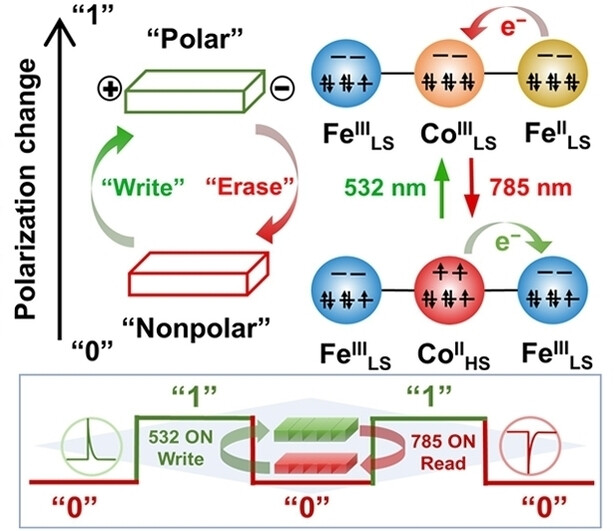
The polarization switching of the [Fe2Co] with photocurrent output was realized via reversible light-induced ETCST. Routing the photocurrent through an integrator yields a stable square wave signal, effectively mimicking the switching of a ferroelectric memory from “0” to “1”. Specific crystal cells are exposed to 532 nm light for writing process, while reading was accomplished by scanning the units with 785 nm light.
Cyclic Peptides
Exploring Macroscopic Dipoles of Designed Cyclic Peptide Ordered Assemblies to Harvest Piezoelectric Properties
- First Published: 26 June 2024
Protein-Engineering | Hot Paper
Strukturaufklärung einer metagenomischen Urethanase und Verbesserung des Hydrolyseprofils durch Protein Engineering
- First Published: 01 July 2024

Kunststoffe wie Polyurethane (PUs) und Polyamide (PAs) widerstehen weitgehend dem biologischen Abbau, was zur Entstehung von Abfall beiträgt. In diesem Artikel stellen wir die erste Kristallstruktur der metagenomischen Urethanase UMG-SP-1 vor. Durch anschließendes Engineering konnten wir Varianten mit einer bis zu 8-fach erhöhten Aktivität für verschiedene Urethane und Amide entwickeln. Darüber hinaus haben wir ein thermoplastisches Polyurethan (PU) und das Polyamid (PA) Nylon 6 teilweise abgebaut, was die Anwendbarkeit von UMG-SP-1 für den biologischen Abbau und das Recycling von PU- und PA-Abfällen unterstreicht.
Distickstoffkomplexe
Synthese und Charakterisierung eines Kupfer-Distickstoff-Komplexes unter Verwendung eines schwach koordinierenden Anions
- First Published: 10 June 2024

Kaskadensynthese: Der Kupfer-Distickstoff-Komplex [(η1-N2)Cu{Al(ORF)4}] (RF=C(CF3)3) mit einer beispiellos hohen N≡N-Streckschwingungsfrequenz von 2314 cm−1 und einer positiven Ladung von +0.10 auf dem terminalen N-Atom wird vorgestellt. Dieser wurde durch eine dreifache Kaskadenreaktion aus Ag[Al(ORF)4] mit CuI-Überschuss synthetisiert, um reines Produkt ohne Ag+-Verunreinigung zu erhalten. [(η1-N2)Cu{Al(ORF)4}] wurde vollständig durch NMR-, Schwingungs- und EDX-Spektroskopie, sowie XRD und quantenchemische Analyse charakterisiert.
Hauptgruppenchemie
Cycloadditionen von Diazoalkenen mit P4 und tBuCP: Ein Zugang zu Diazaphospholen
- First Published: 01 July 2024




